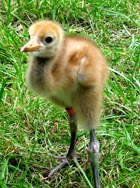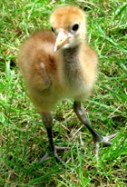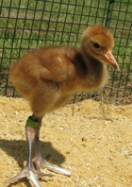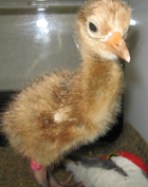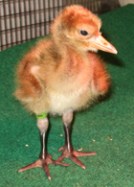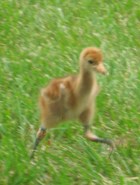All Whooping Cranes released in 2002 were raised by costumed handlers and learned a migration route by following Operation Migration’s aircraft from Necedah National Wildlife Refuge in Juneau County, Wisconsin to Chassahowitzka National Wildlife Refuge in Citrus County, Florida.
The 1200-mile southward migration began October 13, 2002, and ended 49 days later on November 30, 2002.
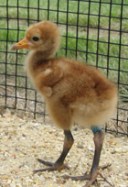
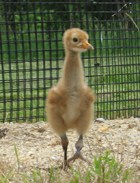
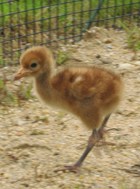
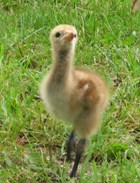
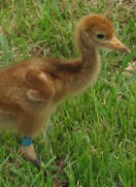

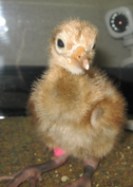
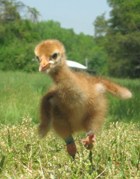
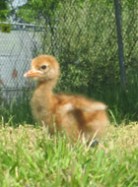
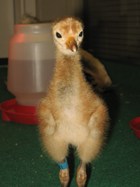
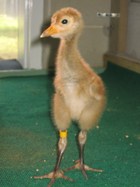
Crane #1-02
Sex: Female
Hatch Date: April 12, 2002
Personality Characteristics: Always easy to work with and a good follower. Buddies with #2-02, another oldest female. These two often picked on the smaller cranes during training.
History
Fall 2002: Cut her leg and required stitches when she bumped into the ultralight on the 3rd flight of the first migration, but rejoined the cohort the same day. Dropped out on the 4th leg but flew well on remaining flights. Successfully finished her first journey south behind the ultralights. During the first winter in Florida, she started showing aggression towards her old buddy, Crane #2-02. She displaced #2-02 from the feeders, the water guzzler, or wherever she happened to be by pecking at and chasing her. “This aggression is very minor, but is an interesting change in their behavior and relationship,” reported Sara Zimorski.
Spring 2003: Left Florida on first journey north April 1, 2003 with 14 other whoopers and returned successfully to Wisconsin with the group, arriving April 13 and 14. Wandered during the summer and seemed to prefer staying in Minnesota’s Dodge County. Hard to keep track of because both her radio and satellite transmitters have failed, but she returned to western Wisconsin by 2003 summer’s end.
Fall 2003: Left on migration from Necedah NWR around November 7, flying alone. Seen at Hiwassee Wildlife Area in Tennessee Nov. 17 and 21. Satellite reading showed she arrived in Florida November 25 and roosted in Madison County with a large flock of sandhill cranes. Moved to Pasco County, Fl with #9-02, #11-02 and #12-02 from her cohort. Moved again December 4 to Marion County, FL. She later broke from the group and went to Lake County, FL by herself.
Spring 2004: Left on spring migration from Lake County, FL on April 6, but was “missing in action” until July 30, 2004, when she was confirmed in south-central in Michigan among sandhill cranes. She did not return to Wisconsin but stayed in Michigan.
Fall 2004: She began migration from Kalamazoo County, MI on or shortly after November 2. Detected flying alone over Illinois Nov. 7. Reported at Hiwassee State Wildlife Refuge in Meigs County, Tennessee on November 10. Departed there to resume migration on Dec. 12. Wintered at Lake Woodruff NWR Florida.
Spring 2005: Hooray! Crane #1-02 returned to Wisconsin! Roosted in Adams County, WI on April 3 with her new mate, crane #6-03. By April 6 the two had moved to Juneau County, WI. They were seen in and around Necedah NWR throughout the summer.
Fall 2005: Began migration with #6-03 on Nov. 17 and was confirmed that night at Jasper-Pulaski SWA in Indiana. Next reported (with #6-03) the end of November at Hiwassee NWR in Tennessee when the 2005 ultralight chicks and other cranes were also there. She and #6-03 arrived at their territory at Lake Woodruff NWR, Florida, on December 20 to spend the winter.
Spring 2006: Began migration from Florida (with #6-03) on March 27 or 28. No reports received during migration. She and #6-03 were found back on their territory in Wood County, Wisconsin on April 6.
Fall 2006: #1-02 and mate #6-03 began migration from Wisconsin’s Necedah NWF on November 9 and made it to northern Illinois that night. They were in Daviess County, Indiana on Nov. 24 and soon made it to their winter territory in Florida.
Spring 2007: Began migration from Volusia County, FL on Mar. 7 with #7-03. They were confirmed back home in Wisconsin during an aerial survey on March 23. On May 17 they were reported building their first nest! She was last observed on June 9, 2007. Her transmitter is nonfunctional, and she cannot be tracked. Her mate, #6-03, was temporarily flightless due to molting his feathers, and was killed by a predator in a dry marsh on or around July 6, 2007. Crane #1-02 may have left her mate in June to escape their drought-stricken territory and find a safer location with water for roosting. She has been missing ever since.
Click here to jump to the top of this page.
Crane #2-02
Sex: Female
Hatch Date: April 16, 2002
Personality Characteristics: With “a bit more spunk,” she causes trouble on her own at times. Quite bonded to the costumes and often picks on the crane handlers wearing them. Cautious and slow to come out of the pen for training and flying.
History
Fall 2002: Successfully completed ultralight-led migration with her Class of 2002.
Spring 2003: Left Chassahowitzka NWR on first journey north April 1, 2003 with 14 other whoopers and returned successfully to Wisconsin April 13. Spent the 2003 summer about 15 miles from Necedah NWR with flock mates #17-02,#11-02, #12-02, #13-02 and#16-02.
Fall 2003: Together with #13-02, started her fall migration from Necedah on November 7. Arrived with #13-02 in Suwanee County, FL on Nov. 21, where the pair stayed.
Spring 2004: Crane #2-02 (with #13-02) likely began their spring journey together on March 20, as PTT readings indicate they spent that night in east-central Georgia. From March 24 – 29, PTT readings indicated they were in Jackson County, IN. Confirmed April 2 (with #13-02) in Tipecanoe County, Indiana. Seen April 6 in Dane County, WI and confirmed back home at Necedah NWR on April 7.
Fall 2004: Remained at or near Necedah NWR until Nov. 28, when she left with Crane #1-01. The two remained with large numbers of sandhill cranes in frozen, flooded farm fields in Jasper County, Indiana, until December 16. On that afternoon they moved to nearby Jasper-Pulaski SWFA. They resumed migration Dec. 17. On December 18 they were tracked to roost with approximately 100 sandhills in Monroe County, Kentucky. They completed their southward migration on December 20, arriving in Pasco County, FL. This is the same wintering location #1-01 used during the previous two winters (2003-04, 2002-03). Shows possible pairing behavior with #1-01.
Spring 2005: The pair #1-01 and #2-02 left their FL winter location on either March 12 or 13. Confirmed back at Necedah NWR in WI by March 29. They established a territory on the refuge.They remained on their territory except on April 15, when they spent much of the day away. On April 16 crane #2-02 was sitting as if incubating in the marsh southeast of the pen at Site 4 on the refuge. On April 17 the two birds left and spent the day south of the refuge. A check of the nest site indicated that one egg had been laid, but it had apparently been destroyed during the previous night (quite common in first-time breeders). The pair came back again to the refuge on April 21. No more nesting, no chicks.
Fall 2005: Breeding pair #2-02 and #1-01 began migration November 17 along with #8-02. On Nov. 30, #2-02 and her mate #1-01 returned to the same Citrus County, Florida area where they wintered at last year. Home!
Spring 2006: #2-02 (and mate #1-01) left on migration from Citrus County, FL on March 12. They arrived at Wisconsin’s Necedah NWR on March 18, where they settled on their old territory. They began incubating on April 7, but on April 16 the eggs were lost to a predator. Again, no successful nesting.
Fall 2006: #2-02 and mate #1-01 began migration from their Wisconsin territory on November 11. They made it to northeastern Illinois on day 1. The pair resumed migration on November 12 and continued with sandhill cranes to Jasper-Pulaski SFWA, Indiana. Arrived Citrus County, FL on Nov. 23!
Spring 2007: Reported entering Georgia on migration with her mate (#1-01) on March 13. Her mate was confirmed back at Necedah NWR on March 26, but without #2-02.
2-02 was last seen March 2007.
Click here to jump to the top of this page.
Crane #3-02
Sex: Female
Hatch Date: April 17, 2002
Personality: At Patuxent WRC, was very private and independent and watchful. Avoided the rest of the flock, an “odd bird” from the start. Later, became a great flyer and very good at following the plane. Resists changes and is a bit of a rebel. She sometimes dropped out and turned back during training flights. High on the dominance scale. Here’s proof: When yearling Cranes #1-01 and #2-01 showed up on the Necedah training site, she actually joined with the “costumes” to chase the intruder cranes away! High on the dominance scale.
History
Fall 2002: On day one of the migration, she dropped out and returned unaided to the pen site at Necedah. Also dropped out on the 3rd leg, but successfully completed migration with her Class of 2002. During the first winter in Florida, she developed an attitude. Crane monitor Sara Zimorski reported, “She displaces many of the younger females (especially #17-02 and #18-02), usually from the feeders, and sometimes from what seems to be a random area. She’ll also stand her ground longer when larger and more dominant birds challenge or attempt to displace her. Chick #3-02 was a very independent chick from the start, which made training her very challenging. With a lot of hard work, she came around and turned into a great bird. However, somewhere in the process of integrating all 17 birds prior to migration, she became more submissive and cautious within the large group. She later got back some of her confidence and independence. She was not letting herself be pushed around as much anymore, and was instead pushing around some of the younger and less dominant chicks.”
Spring 2003: Left Florida in the group of 15 (included one 2001 bird) and arrived Wisconsin April 13. Wandered in her first summer. She and other females #7-02 and #15-02 stayed in South Dakota—too close to the Aransas/Wood Buffalo Whooping Crane path and outside the NEP area—so they were captured and returned to Necedah August 17-18. She flew briefly with the ultralight and new chicks one day after her return! She stayed around the Necedah Refuge until she reunited with #15-02 on August 29, and both flew to northeastern Iowa.
Fall 2003: #3-02 and #15-02 began migration from Iowa on November 8, and completed their migration 7 days later. They were the first “white birds” to arrive in Florida for winter 2003-04. After staying at the pen site, they later moved and were seen Nov. 21 in a marsh in Hillsborough County, FL. Then the two moved to Sumter County, where they spent the winter.
Spring 2004: Left Florida on spring migration after April 11, 2004. Finally, #3-02 and #15-02 were reported in Meeker Co. Minnesota, between April 17-18. (These are two of the three females that wandered west into South Dakota in spring 2003.) However, they were reported back at Necedah NWR in Wisconsin April 19!
Fall 2004: Cranes #3-02, #15-02 and #16-02 began migration from Monroe County, Wisconsin, on November 21. They left Greene County, IN on December 14. They roosted that night in Davidson County, Tennessee. On Dec. 15 the trio flew to Limestone County, Alabama. They remained Alabama until Dec. 23. Crane #15-02 separated from the other two birds and #3-02 and #16-02 arrived at the Florida winter pen site on the afternoon of Dec. 28. The moved to a ranch in Lake County, FL for most of the winter.
Spring 2005: Began migration with #16-02 during March 22-24 and was back at Necedah March 29! In May, observed nest building with #17-03 on the Refuge. The pair stayed around their established territory all summer, but did not nest successfully.
Fall 2005: #3-02 was captured Nov. 11 (after 4 tries) at Necedah NWR so her dead radio transmitter could be replaced. She began migration Nov. 17 with #17-03. The pair later joined in flight with #2-01, #12-02, #1-03 and #11-03. They roosted that night in Will County, Illinois. The group continued Nov. 18 to roost on a river SW of Indianapolis, IN. On Dec. 22 they were detected in flight north of Gainesville, Florida. They landed at their old pen at Chassahowitzka NWR at 5:50 PM! They moved to Sumter County, FL the next day, but returned to check out the “Chass” pen on Dec. 24.
Spring 2006: #3-02 and mate #17-03 left Florida on Feb. 1 with pair #1-03 and #11-03. They were last tracked on 2 February, when they were in flight over Okefenokee Swamp. They were on a heading for the place in South Carolina where #17-03 had wintered one year earlier, but they arrived back on their territory at Wisconsin’s Necedah NWR on March 18 or 19. They built a nest and began incubating on or by April 7. The eggs were lost to a predator on April 15 or 16.
On July 25, the remains of #3-02 were discovered just SE of her nesting marsh. She appeared to have been killed by a predator, possibly on July 22. The drought-stricken area had much very little water for safe roosting.
Click here to jump to the top of this page.
Crane#4-02
Sex: Female
Hatch Date: April 19, 2002
Personality Characteristics: She was heaviest of all the chicks at hatching. Strong–hatched from her shell in record time. A fairly quiet girl, she ranks in the middle of the dominance order. Never gives any trouble. Dan says she is one of the only two Whoopers that he knows of that doesn’t like smelt (tiny fish used for treats).
History
Fall 2002: Successfully finished her first journey south behind ultralights.
Spring 2003: Left Florida in the group of 15 (included one 2001 bird) and arriving Wisconsin April 13. Spent the summer about 10-12 miles from the Necedah Refuge with #9-02 and #18-02. Returned to the Refuge the last week of October, 2003, as did #18-02 and #5-01.
Fall 2003: Migrating together, #5-01, #4-02 and #18-02 were found by trackers while in flight Nov. 20 over Georgia. They flew after dark, roosting in SW Georgia. On November 21 the group of three landed at the pen site at Chassohowitzka, migration complete! With #5-01 and #18-02, later flew to Hernando County, but returned on Jan. 8, 2004 to the the pen site to create trouble. They harassed the young 2003 chicks in the pen and took over a feeding station!
Spring 2004: Left on spring migration March 27, 2004, together with #5-01 and #18-02. They landed to roost in Georgia at 6:15 that evening. Stopped overnight in Indiana April 1. All three birds confirmed back at Necedah NWR on April 7, 2004.
Fall 2004: Arrived Nov. 7 at the Jasper Pulaski State Fish and Wildlife Area in Indiana along with the big male, #5-01. Reported at Hiwassee State Wildlife Refuge in Meigs County, Tennessee on November 10. Observed at Chassahowitzka National Wildlife Refuge, Florida on Nov. 26. She moved away from the pen site after finding nobody there and no free food. Still together with Crane #5-01, she remained on a cattle ranch in Hernando County, FL but sometimes visited the pen site at “Chass” NWR. Will this pair become mates?
Spring 2005: Began migration along with #5-01 and #12-04 on March 30. No aggression by the two older cranes toward the younger one (#12-04), reported ICF trackers who watched the trio at their first night roost in Georgia. On April 5 the two adults left juvenile #12-04. On April 6, #4-02 and #5-01 completed migration to Mill Bluff State Park in Wisconsin. On April 7 the pair moved to their territory on Necedah NWR. No nesting behavior was seen.
Fall 2005: On Aug. 22, Cranes #4-02 and #5-01 moved from their territory on l Necedah NWR to nearby Mill Bluff State Park. This was the first movement from their territory since May 20. The pair began migration on November 21. They were seen at their last year’s winter home on a ranch in Hernando County, FL on Nov. 27. They continued on to the chick pen at “Chass” NWR but returned Nov. 30 to their former ranch site. (Good! The pen is for the new chicks.) The pair returned to Chass Dec. 14 and roosted at the pen site. They moved around a bit, staying in nearby counties, and were on a Pasco County ranch with a few other whoopers by end of December.
Spring 2006: Still in Florida (with #5-01) on March 20; began migration March 20-22. No reports received during migration.They were found back on their territory at Necedah NWR on April 6.
Fall 2006: #4-02 left Wisconsin on Nov. 19 (with #5-01 and #5-02) and made it to northeastern Illinois on day 1. Found with mate #5-01 on their winter territory in Hernando County, FL on Nov. 24. She roosted with her mate at the old Chass pen site on Jan. 8 and 9, 2007. Her mate stayed all week, but #4-02’s signal was not detected after January 13. An air boat search failed to locate her. On January 16, 2007 her remains were found on Stafford Lake in Hernando County. This was a primary winter use area of #4-02 and her mate #5-01, but water levels were very low due to drought. This made it easier for a predator to get her. An exam will be done on her remains.
Click here to jump to the top of this page.
Crane #5-02
Sex: Male
Hatch Date: April 22, 2002
Personality Characteristics: A good-sized male who often picked on the other chicks when he was young. He was chums with with Crane #4-02. He used to follow rebel Crane #3 back to the pen when #3-02 would drop out of training flights. Chick #5-02 ranked in the middle of dominance until he became top bird during the winter 2002-03 in Florida, displacing #13-02 from “first place.”
History
Fall 2002: Successfully finished his first journey south behind ultralights.
Spring 2003: Left Florida in the group of 15 (which included one 2001 bird) and arrived back in Wisconsin April 13. He spent part of the summer in the southwest area of Wisconsin, but his radio signal was detected on the Necedah Refuge again on June 15. He was in the company of crane #2-01 from the Class of 2001 ultralight whoopers.
Fall 2003: Began migration on Nov. 13 with six flock mates and #2-01 from the 2001 flock. This group of eight arrived at the Florida pen site at Chass on November 21, 2003. During their entire 2003 journey south, the group stayed together and was never seen migrating with sandhill cranes. This group moved to Pasco County shortly after arriving in Florida. Five of them, including #5-02, split from the group and moved to the same area of Pasco County that #1-01 and #2-01 occupied in winter 2002.
Spring 2004: Left Florida on spring migration around March 13, together with #1-01, #2-01, #8-02, #16-02, and #17-02. PTT readings indicated the group roosted in SW Indiana on March 22, but moved to DeKalb County, IL on March 23. The group arrived home at Necedah NWR on April 1, 2004.
Fall 2004: #5-02 and #6-03 departed Necedah NWR on Nov. 7 and flew that day to Iroquois County, IL. Next reported at Hiwassee State Wildlife Refuge in Meigs County, TN from November 10 through about Dec. 18. Shortly after, #5-02 and #18-04 (the 2004 chick who was left behind when his cohort made their journey south with ultralights) were sighted at the Hixtown Swamp in Florida—migration complete! Apparently, #5-02 showed new chick #18-04the way to Florida after they found each other in Tennessee. The two settled near where #5-02 spent last winter, on a ranch in central Florida where cranes #11-02, #12-02 and #17-02 were wintering. Wonderful!
Spring 2005: Cranes #5-02, #11-02, #12-02 and #17-02 left Pasco County, FL between March 10 and March 12. Reported on March 13 in Blount County, Tennessee. Confirmed back at Necedah NWR in Wisconsin by March 29. Male #5-02 didn’t pair up with a female.
Fall 2005: Began migration on Nov. 24 with #13-03. Not tracked. On December 1 they reached #5-02’s winter home on a Pasco County ranch in Florida, where he wintered last year. By the end of December, at least 100 sandhill cranes were there along with Whooping Cranes #2-01, #12-02, #8-02, #5-01, and #4-02. The pair (#5-02/#13-03) unison-called when the newly arrived Whooping Cranes flew over them and #5-02 was aggressive toward the other birds; but the 7 whooping cranes roosted together on December 23 and 24.
Spring 2006: Crane #5-02 (together with #13-03) began migration from Pasco County, Florida on February 28. A pair of cranes reported March 3 in Indiana could have been this pair. They were confirmed home in Wisconsin March 17.
Fall 2006: Left Wisconsin on Nov. 19 (with #5-01 and #4-02) and made it to NE Illinois on day 1. Found in Pasco County, FL on Nov. 24. Moved and remained in the subadult flock on a cattle ranch in Pasco County.
Spring 2007: Crane #5-02 left Florida on February 22/23 and was reported in Indiana on March 3-6. Arrived back in Wisconsin on Necedah NWR by March 19.
Fall 2007: Last confirmed on Necedah NWR territory on October 16.
Click here to jump to the top of this page.
Crane #7-02
Sex: Female
Hatch Date: April 27, 2002
Personality Characteristics: Big, strong and sassy. Kelly and Dan say “She’s got attitude.” She sticks up for herself against the costume and other flock mates. Her buddy is Crane #8-02.
History
Fall 2002: When migration began, she dropped out on the 1st leg and returned unaided to the pen site at Necedah. Didn’t exit pen at Sauk Co. site and made the trip in a crate that day. She dropped out on the 4th leg of the journey south. During the first winter in Florida, she was a rather submissive, low-ranking female who rarely bothered anyone, but who was bullied by Crane #5-01.
Spring 2003: Left Florida in the group of 15 (including one 2001 bird) and arrived in Wisconsin April 13. Wandered in her first summer. She and other females #3-02 and #15-02 stayed in South Dakota. This worried biologists as it was too close to the Aransas/Wood Buffalo Whooping Cranes and outside the NEP area. Thus she and the other two were captured and returned to Necedah August 17-18. Crane #7-02 was dominant and the largest of the three, but she suffered capture myopathy from the stress of being captured. She was humanely euthanized at ICF August 30, 2003 when it was apparent she could not recover.
Click here to jump to the top of this page.
Crane #8-02
Sex: Male
Hatch Date: May 2, 2002
Personality Characteristics: Large male, very spunky, with two little pink bald spots on his head. He was the most dominant bird in Cohort 1, the first group of chicks to arrive at Necedah for 2002 training.
History
Fall 2002: Successfully completed migration with the ultralight Class of 2002. During the first winter in Florida, aviculturalist Lara said, “He wants to be dominant. He acts tough toward the costume, often challenging and threatening us when we go in the pen, but is very often displaced by birds in the flock.” Bullied by Yearling Crane #5-01 during the winter of 2002-03.
Spring 2003: Left Florida in the group of 15 (including one 2001 bird) and arrived home in Wisconsin April 13. He spent part of the summer in the southwest area of Wisconsin along with #5-02, and apparently chose to stay there even when #5-02 returned to the Refuge.
Fall 2003: Began migration on Nov. 13 with six flock mates and #2-01. This group of eight arrived at the Florida pen site at Chassahowitzka NWR on November 21, 2003. During their entire journey south, the group stayed together and was never seen migrating with sandhill cranes. This group moved to Pasco County shortly after arriving in FL. Five of them, including #8-02, split from the group and moved to the same area of Pasco County that #1-01 and #2-01 occupied in winter 2002.
Spring 2004: Left on spring migration around March 13, together with #1-01, #2-01, #5-02, #16-02, and #17-02. PTT readings indicated the group roosted in SW Indiana on March 22, but moved to DeKalb County, Illinois March 23. The group arrived back at Necedah NWR on April 1, 2004.
Fall 2004: The pair #102 and #208 began migration from Necedah NWR on Dec. 1. Checked and confirmed in Illinois on Dec. 14. Detected in flight just east of Decatur, Alabama on the afternoon of Dec. 23. They arrived at the Florida winter pen site on the afternoon of Dec. 30 and later moved on to other territory.
Spring 2005: #8-02 and #2-01 departed on migration from Pasco County, Florida on March 19 and were back at Necedah on March 31! He often intruded on the territory of pair #1-01 and #2-02 and was chased off by #1-01. He was seen several times with #13-03 during the summer. In the fall, #208 often aggravated and challenged #1-01 on #1-01’s territory.
Fall 2005: #8-02 began migration November 17 with #1-01 and #2-02. They roosted on a pond in Will County, Illinois. The group continued Nov. 18 and stoped near Indianapolis, Indiana. On Dec. 22, #8-02 arrived at the Chassahowitzka NWR pen site in Florida . He left the next day for a cattle ranch in Pasco County, FL. where several other whoopers and many sandhill cranes spent the winter.
Spring 2006: Crane #8-02 (together with #12-02 and #2-01) began migration from Pasco County, Florida on February 28. He was with the pair in Greene County, Indiana, March 7-12. He arrived back at Wisconsin’s Necedah NWR March 18 or 19.
Fall 2006: Crane #8-02 and his mate (#13-03) were among the last Whooping Cranes to leave Wisconsin’s Necedah NWR in November. Since Dec. 4 the pair had been at a migration stopover in Indiana. On Dec. 23, #8-02 was discovered still alive but in shock under a power line there. He was retrieved and transported to the Indianapolis Zoo hospital for intensive care. An injury to his right leg later became apparent. The facilities were excellent and suitable for maintaining the costume/isolation protocol. He died suddenly on Dec. 27, 2006 following tube feeding. Project biologist Dr. Richard Urbanek said, “#8-02 was a model bird and was expected to nest this coming spring on his territory on Necedah NWR. ” It is a sad loss.
Click here to jump to the top of this page.
Crane #9-02
Sex: Female
Hatch Date: May 9, 2002
Personality Characteristics: One of the two youngest. Small. She wants to be close to the costume (“Mommy”). She is also very bonded to the trike and is a good flyer. She likes to fly near and tight to the trike, rather than out behind the wing where she can benefit from the air current off the wing tip. She has to flap-fly when she’s up close to the trike, which could make her tired. The caretakers say she’s a crybaby and always wants to be near them.
History
Fall 2002: Successfully completed migration with the ultralights and Class of 2002. During the first winter in Florida, she was probably the most submissive bird in the flock, but yearling Crane #5-01 seemed to like her and protect her, even as he bullied some of the other chicks.
Spring 2003: Left Florida on first journey north April 1, 2003 with all the rest of the cranes, but hesitated and turned back alone. Made the migration by herself, wandering off track. After a hide-and-seek game from ground and air in 3 states, she was captured, crated, and flown from Ohio to Necedah in a plane on May 4. After leaving the group for 4 days and then returning, she spent the summer of 2003 about 10-12 miles from the Necedah Refuge with #4-02 and #18-02. Because she missed 391 miles (6 flight segments with the ultralight) and was flown back to Necedah, the pilots and handlers were concerned. How will she find the Florida wintering grounds on the 2003 journey south if she chooses again to travel alone?
Fall 2003: Luckily, she joined with other cranes and began migration on Nov. 13 with six flock mates and #2-01. This group of eight arrived at the Florida pen site at Chassahowitzka on November 21, 2003. During their entire journey south, the group stayed together and was never evcen seen migrating with sandhill cranes. This group moved to Pasco County shortly after arriving in Florida.
Spring 2004: On March 18, 2004, #9-02 departed from the Pasco County winter location with Cranes #11-02 and #12-02. They spent that night in southern Georgia. Since she made the fall 2003 journey south without getting lost, everyone was hopeful that she’d be able to simply reverse course and arrive back in central WI and NOT Ohio. Sure enough, that’s what she did! The three whoopers roosted in McHenry County, IL on March 25 and 26. They were next seen at Necedah National Wildlife Refuge–HOME! They likely returned on March 27, 2004. Crane #9-02 separated from the other two males by March 29 but stayed in the local area.
Fall 2004: Began migration Nov 21 along with #13-02 and #18-02. They remained in Franklin County, Tennessee for the entire winter.
Spring 2005: Began migration with #13-02 and #18-02 from their wintering area in Franklin County, Tennessee on March 21. Confirmed back in Wisconsin at Necedah NWR by March 29. On April 4, #9-02 had parted from #13-02 and #18-02. She stayed around the area of Mill Bluff, WI and she associated with other Whooping Cranes there.
Fall 2005: Began migration with #2-03 on Nov. 17. Eventually joined #1-01, #2-02, and #8-02 to roost that night in Will County, IL. On Nov. 18 they moved to Lake County, Indiana. On Nov. 24, cranes #9-02 and #2-03 foraged in local wetlands and stayed around for the rest of the week.
Spring 2006: Arrived in Wisconsin March 18. Cranes #9-02 and #2-03 are a possible new breeding pair! They were observed building a nest on March 27, but they discontinued use of that site. They chased #17-04 from a cornfield near their territory on April 7. On April 13, they began incubating eggs in a new nest on their territory in Monroe County, Wisconsin. They did better than of any of the 5 nesting pairs, guarding their eggs and staying on the nest. But their clutch was lost after 15 days, before the eggs could hatch. She later lost her mate (#2-03) when he was predated. The two were siblings.
Fall 2006: Left Wisconsin on Nov. 19 (with #16-04) and made it to NE Illinois or NW Indiana. Next reported in Newton County, Indiana but had left (with #16-04) by Dec. 3. Reported still with large numbers of sandhill cranes in Jackson County, Indiana. They did not leave until the first week in February when the coldest arctic air mass of the season chilled the Midwest.
Spring 2007: Crane #9-02 (and #16-04), who wintered in Indiana, were observed back in Wisconsin and building a nest by March 26! They didn’t finish, but later built another in which they laid eggs. This is #9-02 sitting on the active nest on April 15, 2007:
The nest was not successful and the pair was not detected after May 27.
Fall 2007: #9-02 and mate (#16-04) migrated fom Wisconsin on November 22 but their transmitters don’t work and the pair cannot be tracked. They remained in Jackson County, Indiana through the end of December.
Spring 2008: Female #9-02 and male #16-04 began migration from Carroll County, Georgia, on February 2. Two birds believed to be this pair were reported on their territory at Monroe County Flowage on March 30, and identification was confirmed on April 7. They nested, but a broken egg was discovered via an aerial survey of nests on April 14. Also, #9-02 was found to be limping severely with her right leg when the pair’s territory in Monroe County was checked April 23 and again in early May.
Only one Whooping crane was spotted on an aerial survey July 1 and an ultralight flight August 30 confirmed only one bird on the territory. Leg bands identified it as #9-02’s mate, male #16-04. Dr. Richard Urbanek said, “Based on this information, female #9-02 is presumed dead, and mortality probably occurred during May.”
Click here to jump to the top of this page.
Crane #10-02
Sex: Male
Hatch Date: May 11, 2002
Personality Characteristics: Aggressive to the costume and stamps his feet if the costume approaches. Joe explains that they have to be dominant over #10-02. They do this by holding the puppet over #10-02’s head. He tries to fight for position, like a little brother or sister trying to get some attention. He is hostile to Brian and Kelly and often challenges them when they enter the pen.
History
On October 13, the day the migration finally took off, #10-02 struck the ultralight while in flight. He was injured. Upon landing, #10-02 was taken to Dr. Barry Hartup, veterinarian at the International Crane Foundation, for care. Because recovery would take some time, the team leaders decided to take #10-02 out of the migration. Health care staff worked hard to help the crane, but he did not get well. After 12 days of care, the health team felt that #10-02 would not recover. On October 25, 2002, Crane #10-02 was humanely euthanized. Everyone was sad. This was a big reminder that risks are part of any scientific study.
Click here to jump to the top of this page.
Crane #11-02
Sex: Male
Hatch Date: May 13, 2002
Personality Characteristics: Friendly with the costume but very dominant with the other birds. Kind of a bully. Gets excited about things. The caretakers call him a “wacky whooper” because he will fight with gates, plants and rocks. Caretaker Mark thinks #11-02 hallucinates and acts as if he is killing snakes by stomping them.
History
Fall 2002: Successfully finished his first journey south behind ultralight plane.
Spring 2003: Left Florida on first journey north April 1, 2003 with fourteen other whoopers. Returned successfully to Wisconsin April 13. Spent the summer about 15 miles from Necedah NWR with five flockmates. Bonded with #12-02 and they were often seen back at Necedah NWR in late summer.
Fall 2003: Began migration on Nov. 13 with six flock mates and #2-01. This group of eight arrived at their old pen site in Florida on November 21, 2003. During their entire journey south, the group stayed together and didn’t even mix with sandhill cranes. This group left the old pen and moved to Pasco County shortly after arriving in Florida.
Spring 2004: On March 18, 2004, #11-02 departed from the Pasco County winter location with Cranes #9-02 and #12-02 and spent that night in southern Georgia. They roosted in McHenry County, IL on March 25 and 26. They were next seen at Necedah National Wildlife Refuge—HOME! They most likely arrived on March 27.
Fall 2004: Remained at or near the Necedah NWR until Dec. 11, along with #12-02 and #17-02. Arrived at the Florida pen site at 12:45 EST December 15. They flew the whole route in just 4-1/2 days! They roosted that night in the pool within the pen, near the top-netted enclosure containing the 13 newly-arrived 2004 chicks. On December 16 they stayed at the pen all day and night. The trio of #11-02, #12-02 and #17-02 spent time at or near the pen but moved on Dec. 26 to the Pasco County site that was used by #11-02 and #12-02 during winter 2003-04. Cranes #11-02, #12-02 and #17-02 sometimes returned to the pen site and were hostile to #14-02 when she also returned. They drove her away.
Spring 2005: Crane #11-02 (with #5-02, #17-02, and #12-02) departed Pasco County, FL between March 10 – 12. Confirmed back at Necedah NWR in Wisconsin by March 29. On the evening of 17 April, #17-02 (female) stayed on the nest the pair built in the pond on the east side of the dike, while #11-02 (male) roosted alone on the west side of the dike on their pond. This behavior could indicate that laying of an egg is imminent. Sure enough! They laid an egg in their nest, probably April 19. Unfortunately, the pair left the nest site and moved off the refuge by late afternoon, leaving the nest unattended during the night. The next morning the egg was gone, apparently taken by a raccoon or other predator. The pair remained together on or near their territory at Necedah NWR all summer. In the fall they foraged in a field along with the direct autumn release (DAR) chicks with only minor aggression. If other adults appeared around the DAR chicks’ home, pair #17-02 and #11-02 usually drove them away.
Fall 2005: Began migration from Wisconsin shortly after sunrise on Nov. 24 with #17-02. They were not tracked. The pair reached their former pen site in Florida on December 1. They moved to a ranch in nearby Pasco County and sometimes associated with #5-02 and #13-03, as well as with small groups of sandhill cranes.
Spring 2006: Crane #11-02 (together with #17-02) began migration from a cattle ranch in Pasco County, Florida on February 28. They apparently arrived on their territory at Necedah NWR in Wisconsin on March 28. They built a nest and were confirmed incubating on April 11! But on April 20 both these adults were seen foraging together, an indication that their nest had failed. Biologists examined the nest site on the morning of April 21. No egg remains were found in or near the nest. A crane egg shell, believed to be from this Whooping Crane nest, was found on the dike about 300 meters from the nest, probably carried there by an avian predator. See photos. Then—surprise! This pair nested again and began incubating on May 23 at the original nest site they used last year. This time they stayed with their eggs. On June 22, 2006, experts watching through binoculars saw that the adult cranes’ behavior had changed. The eggs had hatched! Twin chicks were confirmed on June 23. What a celebration! The new Eastern flock has its first family! Follow their story in our First Family photo slide show.
Fall 2006: The First Family left on their first migration south on Nov. 19, the day that a record total of 28 whooping cranes began migration. The parents and their surviving female chick (called W1-06) made it that day to Indiana! On December 9, 2006 at 4:08 pm parents #11-02 and #17-02 and their surviving chick arrived at the Florida pen site. The new parents brought their chick to the same place THEIR parent, the ultralight plane, brought them in 2002. WELL DONE! The family later moved to a lake in a large housing development in Hernando County, FL (not a good idea). They left that location in after February 22.
Spring 2007: The First Family (Dad #11-02, Mom #17-02, and chick #W1-06) began migration from Florida on Feb. 23. No further confirmed reports were received until March 20 when the radio signals of #11-02 and #17-02 and their chick #W601 were confirmed back on Necedah National Wildlife Refuge in Wisconsin! Their chick is the first wild-hatched chick in the eastern migratory population, and the first to complete a roundtrip migration by following her parents — a milestone for the reintroduction of this new flock! By March 26, the chick had separated from the parents (normal behavior). The adults built a new nest and began incubating eggs on April 3. The nest was later abandoned; they began building another nest around May 17, but they did not hatch eggs this year.
Fall 2007: Pair #11-02 and #17-02 left on migration November 22, 2007. Found in Vermillion County, Indiana, on November 24 and still there when trackers checked on December 13. They were gone when the area was checked on December 23. On January 3, 2008, ICF tracker Eva detected signals for #11-02 and #17-02, the First Family parents. Eva confirmed the birds had landed at the Chassahowitzka pen site by making a trip to the boat ramp where she could once again hear their signals coming from the direction of the pen site. They stayed the night at the pen site. Eva wondered where they’d go next. She monitored them. The next morning they took off at 11:30. At noon they landed on their former territory and found W1-06, their female offsping from 2006!
Juvenile W1-06 was on her parents’ territory when they arrived on January 4, 2008. Eva watched the family reunion. All 3 whooping cranes were less than 1 meter apart then W1-06 started walking away. The parents caught up with her and the family then walked and stopped and foraged together. It will be interesting to see what happens next. Will they chase the youngster away, which would be expected behavior? Trackers will continue to monitor these three birds closely to see how they interact.
On Feb. 15, 2008, the two adults left their territory and flew to visit their old “Chass” pen where the Class of 2007 now lives. The adults landed in the pen and the chicks immediately ran and flapped to them, attacking intruders who dared enter their territory. The adults took the hint and flew a short distance away, with chicks on their tails. They were chased from the pen in a matter of minutes, flying to the west to land in a nearby creek. They got the message and didn’t come back!
Spring 2008: On either February 16 or 17 the pair left their winter territory. They were not tracked, but First Parents #11-02 and #17-02 were confirmed at Necedah NWR on March 25. The pair began incubating on April 7. Hopes for chicks were dashed when they deserted their nest on May 6, with 2 fertile eggs, after a surge of warm weather. This is the second time the pair has abandoned a nest.
Fall 2008: Began migration from Necedah NWR on November 15 with mate #217. They were found in Cherokee County, Alabama, at the end of December and beginning of January.
Spring 2009: Began migration from Cherokee County, Alabama, before March 8 with mate 217. Reported in Vermillion County, Indiana during March 9-14. (The refuge datalogger detected the presence of one bird at Necedah NWR on March 16.)
Both birds were confirmed there on March 19 and incubating on a nest April 7! Black flies that hatched in a heat wave tormented the nesting adults and he nest failed before the eggs could hatch. The pair built a second nest — and became the new flock’s first second-time parents when their chick hatched in June! The behavior of the pair indicated that the chick hatched on June 14 or 15, but visual confirmation was difficult to obtain until June 18 due to dense vegetation. This chick is W2-09 (W for wild, 2 for second hatched in the year 09). HOORAY! This is the second time in over a century that a naturally produced Whooping crane has hatched in the wild in the Midwest, and both came from pair 11-02 & 17-02!
Sadly, W2-09 disappeared at just two weeks of age. The chick was last visually confirmed at 1:00 p.m. on June 28. The parents seemed to be tending the chick the early evening of June 29, but the chick could not be seen due to marsh vegetation. The parents were first observed behaving as if no chick was present around noon on June 30, and the movements of the parents have confirmed the loss of the chick.
Pair #11-02 & 17-02 did a lot of flying between the pen site of the DAR chicks and the pen site of the ultralight chicks over the last weeks of summer and early fall.
Fall 2009: Pair #11-02 & 17-02 began migration from Necedah NWR with several other Whooping cranes on Nov. 26, migrating as a group before landing to roost at an undetermined location(s) in Illinois. On Nov. 28 the pair was at one of their previously used stopovers in Vermillion County, Indiana. His mate was shot to death sometime between that sighting and Dec. 1 when her carcass was discovered. Indiana Department of Natural Resources conservation officers and U.S. Fish and Wildlife Service special agents are investigating the incident. The U.S. Fish and Wildlife Serviceand other groups are offering a reward to the person or people who provide information leading to a conviction. Successful breeding pairs mate for life, and now male #11-02 is without his mate. Experts are hoping he will find another female that he wants as his mate. As of December 26, he was still in Vermillion County, Indiana, alone. What will he do? Stay tuned.
Spring 2010: Male #11-02 was observed back home on Necedah NWR in Wisconsin on March 16! The male of the First Family is alone; his mate, #17-02, was shot in Indiana in December. He was observed unison-calling with#46-07 DAR on April 1, but the female apparently rejoined her mate #2-04 on East Rynearson Pool on the following day. He later joined up with female #30-08 and the two claimed as their territory the area where the Direct Autumn Release chicks were set free to associate with older Whooping cranes who could lead them south.
Fall 2010: Adult pair #11-02 and #30-08 were found in Vermillion County, Indiana on Dec. 2. Hooray for the older crane pair who showed young #19-10 DAR (Pepper Jack) the way! They were foraging in snowy cornfields. The adult pair had claimed the DAR introduction site at Necedah National Wildlife Refuge as their territory during the summer, so the young Direct Autumn Release (DAR) chick called Pepper Jack had followed them around and knew them well. Will these three continue together from Indiana to warmer grounds farther south? yes! They were in Cherokee County, Alabama until at least January 26 but were gone when the location was checked on February 1, 2011. The pair and young #19-10 DAR were reported in Madison County, Alabama at least through February 14 along with cranes 37-09 DAR, 25-10 DAR and 27-10 DAR.
Spring 2011: Left Madison County, Alabama sometime between Feb. 18-22 in a group with his mate #30-08 and #19-10 (DAR) and cranes 37-09 DAR, 25-10 DAR and 27-10 DAR. They were reported in Crawford County, IL on March 8-10 and Mar. 14, and completed migration to Necedah NWR by March 21. Male 11-02 had seven previous nests with another mate, but this year his new mate was female #30-08. The pair built their first nest and began incubating on April 16. Their nest failed May 12 and they did not nest again.
Fall 2011: Migrated to Vermillion County, Indiana with mate #30-08.
Spring 2012: Male #11-02 returned March 7 to Necedah NWR for the summer nesting season, but he is without his mate, who died during the winter.
Winter 2012: No news.
Spring 2013: Male #11-02 returned March 23 to Necedah NWR for the summer nesting season, but still without a new mate. ICF tracker Eva reports, “11-02 is on the prowl and has stolen #26-07 away from #4-08… but this happened last spring as well, and it isn’t over until there is a nest!” Sure enough, before May 3 the new pair had built a nest together, but it failed in early May when a heavy black-fly outbreak occurred and tormented many of the crane pairs off their nests.
Fall 2013: Male #11-02 and mate #26-07 migrated to Vermillion County, Indiana.
Spring 2014: Back in Juneau County Wisconsin, male #11-02 and his mate #26-07 had an active nest by April 30. One chick seen with the parents on the May 29 survey flight but did not survive the summer.
Fall 2014: Male #11-02 and his mate #26-07 left on migration sometime between October 17-23 and stopped at their usual location in Vermillion County, Indiana, through at least 3 January; however (unlike last year) they apparently didn’t want to remain through the colder weather and continued to Cherokee County, Alabama for the winter.
Spring 2015: Male #11-02 and his mate #26-07 were back in Juneau County Wisconsin by the March 25 aerial survey flight by Wisconsin DNR pilot Bev Paulan.The pair’s first nest failed on April 15 but they re-nested and had two more eggs. Unfortunately, his mate died and her remains were collected on her second nest on May7th. After the death of his mate, he was associating with juvenile female #20-14, one of the parent-reared (PR) chicks released near adult cranes in fall 2014.
Fall 2015: Spent the winter in Cherokee County, Alabama with mate #15-09.
Spring 2016: Male #11-02 and his mate #15-09 were reported back in Juneau County, Wisconsin, with a renest observed on pilot Bev Paulan’s May 5th survey flight. They hatched chicks on May 27 and May 29. Chick W11-16 was likely predated on June 17; chick W12-16 was still with parents on their territory on July 5, but not seen on the July 15 survey. However, male (#11-02) was last seen on territory with his mate and chick. His carcass was recovered in August. The death of this 14-year-old male is a big loss to the flock.
Click here to jump to the top of this page.
Crane #12-02
Sex: Male
Hatch Date: May 15, 2002
Personality Characteristics: At first he would venture into the marsh but later became a good follower. Little #12-02 was always ready to fight anything in his way.
History
Fall 2002: Successfully migrated south with ultralights and Class of 2002 crane chicks.
Spring 2003: Left Florida on first journey north April 1, 2003 with 14 other whoopers and returned successfully to Wisconsin April 13. Spent the summer about 15 miles from Necedah NWR with flock mates #17-02, #2-02, #11-02, #13-02 and #16-02. Formed a pair bond with #11-02 and they were often seen back at Necedah NWR in late summer.
Fall 2003: Began migration on Nov. 13 with six flock mates and #201 from the 2001 flock. This group of eight arrived at their old Florida pen site on November 21, 2003. During their entire journey south, the group stayed together and was never seen migrating with sandhill cranes. This group moved to Pasco County shortly after arriving in Florida.
Spring 2004: On March 18, 2004, #12-02 departed from the Pasco County winter location with Cranes #11-02 and #9-02 and spent that night in southern Georgia. They roosted in McHenry County, IL on March 25 and 26. They were next seen at Necedah National Wildlife Refuge—HOME! They likely arrived on March 27, 2004.
Fall 2004: #12-02 remained at or near the Necedah NWR (along with #11-02 and #17-02) until Dec. 11. Arrived at the Florida pen site December 15—flying the whole route in just 4-1/2 days! They roosted that night in the pool within the pen, near the top-netted enclosure containing the 13 newly-arrived 2004 chicks. On December 16th they stayed at the pen all day and night. On December 17 these 3 moved 1 mile west of the enclosure but visited the pen often. The trio of #12-02, #11-02 and #17-02 moved on Dec. 26 to the Pasco County site, which was used by #11-02 and #12-02 during winter 2003-04. Cranes #11-02, #12-02 and #17-02 sometimes returned to the pen site and were hostile to #14-02 when she also returned. They drove her away, and #12-02 chased her to her final location.
Spring 2005: Cranes #12-02, #5-02, #11-02 and #17-02 departed Pasco County, FL between March 10 and 12. Reported on March 13 in Blount County Tennessee. Confirmed back at Necedah NWR in WI by March 29. Remained in the area all summer.
Fall 2005: Began migration November 17 with #2-01. They later joined whoopers #3-02 and #17-03 and #1-03 and #11-03 in flight. They roosted on a pond in Will County, Illinois. The group migrated Nov. 18 to near Indianapolis, Indiana. He and #2-01 arrived on a cattle ranch in Pasco County, Florida on December 22. The two hung out with #5-01, #4-02, #8-02, #5-02 and #13-03, particularly on roost at night. They were often with or near large groups of migratory sandhill cranes.
Spring 2006: Crane #12-02 (together with #8-02 and #2-01) began migration from a ranch in Pasco County, Florida on February 28. They were reported in Greene County, Indiana, from March 7-12. They arrived at their Wisconsin summer home March 18 or 19. These two were thought a possible new breeding pair, but then #2-01 left #12-02 on March 25 and was not located during the week. Crane #12-02 then intruded on the pair #16-03 and #12-03 to drive them apart in an attempt to pair with #12-03. Cranes #12-02 and #12-03 were no longer there on March 30, and not located later.
Fall 2006: Left on migration with #419 on Nov. 30. The two were not seen again until February 19, 2007 when they were seen on Okefenokee NWR in Georgia during an aerial survey. They were not with sandhills.
Spring 2007: Seen with #19-04 on February 19 on Okefenokee NWR in Georgia during an aerial survey. A pair observed in Wood County, Wisconsin on March 19 may be this pair. They were in Wisconsin for the summer nesting season but did not nest.
Fall 2007: Pair #12-02 and #19-04 left on migration November 22, 2007. Found on Hiwassee WR in Meigs County, Tennessee, on December 1. They Were soon back on territory in Pasco County, Florida.
Spring 2008: Began migration March 6 from Pasco County, Florida. On April 24 Sara Zimorski sent exciting news: “Both of these birds have non-functional transmitters but the nest location is between their two main use/territory areas, I detected no signals in the area, and there are really no other possible birds this could be. This was a particular good and important find because we hadn’t yet confirmed these two back in Wisconsin, even though we suspected they were back and likely nesting.” Sara took this photo from the plane. See the crane sitting on the nest?
The nest of #12-02 and #19-04 in Wood County failed in early May. A nest check found one undeveloped egg that was infertile. The pair had no further nesting activity this summer.
Fall 2008: Pair #12-02 and #19-04 cannot be tracked but were found on their previous wintering territory in Pasco County, Florida, on January 9. Trackers twice tried to capture this crane pair to replace their transmitters, but the birds escaped the Feb. 20 and March 4 capture attempts.
Spring 2009: Pair #12-02 and #19-04 departed on migration on March 4 when trackers were trying to capture them to replace their radio transmitters. However, they were found at the Chassahowiztka pen site that night and finally captured for transmitter replacements on the following morning. They resumed migration from the pen site on March 6. The pair was detected in northbound flight over Tennessee on March 8 and Kentucky on March 9. They were on course toward a favorite stopover in Greene County, Indiana, where they were from March 13 until they resumed migration on March 21. They had completed migration by the end of March. The pair was found April 9 on a nest, incubating! The nest failed when black flies tormented the parents off the nest, but by May 21 the pair was re-nesting about 50 meters west of their previous failed nest.
Fall 2009: He and his mate #19-04 began migration on November 15, a day with clear skies and north winds to help push them south. Ten whoopers began migration the same day. They were reported in Greene County, Indiana, on November 20, where they remained at least until the end of November. They spent winter on their old territory in Pasco County, Florida.
Spring 2010: He and mate #19-04 began northward migration on March 8. They were reported in Greene County, Indiana, on March 11 and stayed until March 18-22. They were back on their Wisconsin territory in Wood County March 20-21! They already had a nest by April 5 but by April 14 the nest had failed. But cranes often try nesting again. Sure enough, By May 9-11, this pair had renested! They have a history of infertile eggs. On June 6, ICF’s Sara Zimorski and Eva Szyszkoski replaced the pair’s two infertile eggs with one fertile egg from a captive pair at Patuxent WRC in Maryland. With the trade complete, the egg hatched the next day. They became parents of a newly-hatched chick (W3-10) on June 7. Hooray!!!!! They were good parents and by the end of August their chick was seen in flight with them. The chick was captured, banded and released on Oct. 7, now ready for fall migration.
Fall 2010: The Wood County family (#12-02, #19-04 and their chick W3-10) began migration on November 4! They flew all the way to the parents’ regular stop in Greene County, Indiana! The family remained there until the morning of December 6. They were next found during an aerial survey on December 13 on the adults’ wintering territory in Pasco County, Florida—migration complete! Well done, new parents!
On Feb. 9, 2011, ICF tracker Eva sent this photo of father and chick. “They will probably be migrating back north in the next couple weeks or so. Maybe they’ll turn up at the Chass pen site before they leave for good, as they have in the past! We’ll just have to wait and see.”
Spring 2011: Pair #12-02 and #19-04 and their juvenile W3-10 began migration from Pasco County, FL sometime between Feb. 19 and 23. They were reported March 1 in Greene County, IN. The family stayed at least through March 5. On the evening of March 20 the family was reported in Kane County, IL. On March 23, tracker Jen sent word: “I just heard signals of the Wood County family (W3-10, and parents #12-02 and #19-04) over Baraboo, Wisconsin!” The family was back on on their Wood County territory March 25. Two days later they moved to another location where the adults left the chick before returning to their Wood County territory. (As of April 3rd, W3-10* remained in the area she was left by her parents.) The adults began incubating a new nest on April 13. The nest failed May 15, with 2 infertile eggs collected after overlong (32 days) incubation.
Fall 2011: Pair #12-02 and#19-04 wintered in Green County, Indiana.
Spring 2012: Male #12-02 and mate #19-04 were detected in flight March 15 with several other Whooping cranes as they headed north over ICF in Baraboo, Wisconsin—close to Necedah NWR. They were found with a nest on April 2. They hatched a chick—the first wild-hatched chick of the eastern flock’s 2012 season—on April 30! The chick (#W1-12) was observed by tracker Eva Szyszkoski of ICF. Chick W1-12 survived to fledge and migrate with the parents!
Fall 2012/Winter 2013: Male #12-02 and mate #19-04 were observed along with their youngster #W1-12 in Indiana on December 12 (photo below). Will they continue migration to their usual winter territory in Pasco County, Florida, this year?
The pair with their chick did NOT continue migration to their usual winter territory in Pascoe County, Florida, but instead spent the winter in Indiana. The photo below was taken in February 2013 by Steve Smith. Female #19-04 at the left, chick #W1-12 in the middle, and male #12-02 on the right.
Steve Smith photographed the family again March 12 at Goose Pond fish and Wildlife Area in Greene County, Indiana. The cranes’ leg bands identify them as #19-10 DAR, male #12-02, female #19-04 and this pair’s now-subadult offspring W1-12.
Spring 2013: Male #12-02 and mate #19-04 completed spring migration back to Wood County, Wisconsin on April 2 along with their offspring from last summer, male sub-adult #W1-12. Will this pair raise another chick this summer? By mid April they were already sitting on a nest! The nest was observed by pilot Bev Paulan on an April 16 flight over crane territory, but the failed on May 5 and they did not re-nest. No chicks this summer for this pair.
Fall 2013: Pair #12-02 and #19-04 migrated to Greene County, Indiana, where they were reported on January 26.
Spring 2014: Pair #12-02/#19-04 were confirmed back on their territory in Wood County, Wisconsin, on 28 March. 12-02 and 19-04. They were sitting on a nest in Wood County, WI when observed in mid April. On May 13 tracker Eva Szyszkoski confirmed that the pair hatched chick #W3-14! By July, their chick was the only survivor of the wild-hatched chicks of summer 2014.
Fall 2014: Male #12-02 was wildly upset when his chick, #W3-14, was captured by costumed handlers Sept. 8 for banding (photo below). His mate, #19-04, went missing during the summer and is presumed dead, so he alone will lead his youngster on its first migration this fall.
Male #12-02 and his 5-month-old chick, #W3-14, began migration from his territory in Wood County, WI sometime between October 17th and 20th. The two were reported in Greene County, Indiana, by October 22, along with five other Whooping cranes from the eastern flock. He and his youngster left Greene County, Indiana, and moved south to Lawrence County, Alabama, the first week in January with #29-09, #19-10 DAR and #4-11. This group left Lawrence County, Alabama, and returned to Greene County, Indiana on February 7, 2015.
Spring 2015: Male #12-02 began migration from Green County, Indiana with female #4-11 on March 18-21, leaving his chick, W3-14, behind in the company of female #7-12. He was seen back on his Wisconsin territory during a March 25 aerial survey. He paired with female 4-11 and the two had an active nest by early May. No further news of any nesting success this spring.
Fall 2015: Male #12-02 was confirmed in Green County, Indiana with mate #4-11 by November 12 after migrating sometime within the two previous weeks. Several other whoopers from the eastern flock were also in Green County, IN.
Spring 2016: Male #12-02 and mate #4-11 were observed on their Wisconsin territory by March 30. They nested and were first seen with their little chick, W3-16, on May 3. Male #12-02 was found dead in early June. There was no sign of predation or injury; death was later determined to be due to a possible bacterial infection. His mate and chick were still doing well as of July 5, but It is a sad loss for the flock to lose this long-term survivor and good father.
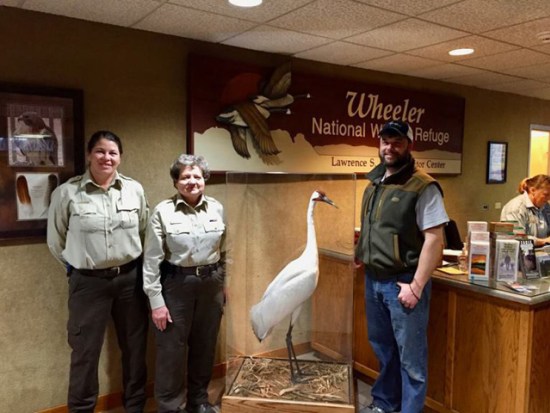
Click here to jump to the top of this page.
Crane #13-02
Sex: Male
Hatch Date: May 16, 2002
Personality Characteristics: “He’s the boss—a big, tough bird,” say Kelly and Dan. Most dominant on the ground but not in the air. He started out as top bird during the first winter in Florida, but #5-02 replaced him in the dominance structure.
History
Fall 2002: Successfully finished his first journey south behind ultralight plane.
Spring 2003: Left Florida on first journey north April 1, 2003 with 14 other whoopers. Returned successfully to Wisconsin April 13. Spent the summer about 15 miles from Necedah NWR with flock mates #17-02, #2-02, #11-02, #12-02 and #16-02.
Fall 2003: Together with #2-02, started fall migration from Wisconsin on November 7. Arrived with #2-02 in Suwanee County, FL on Nov. 21. The two stayed there all winter.
Spring 2003: Male #13-02, still with #2-02, began spring migration on March 20. PTT readings indicate they spent that night in Georgia. From March 24-29, PTT readings indicated they were in Jackson County, IN. Confirmed April 2 (with #2-02) in Tipecanoe County, Indiana. Back “home” at Necedah NWR on April 7.
Fall 2004: Began migration Nov 21. The trio of #13-02, #18-02 and #9-02 had remained in a flooded area in Franklin County, TN through early March 2005.
Spring 2005: Began migration with #9-02 and #18-02 on March 21. Confirmed home in Wisconsin at Necedah NWR by March 29. The pair of #13-02 and #18-02 began building a nest near the site 2 training area! However, the nest was never completed and no eggs appeared. This pair moved between the refuge and the Mill Bluff area but stayed on their territory at Necedah NWR most of the time.
Fall 2005: Began migration Nov. 17 with #218. They landed to roost at 5:24 p.m. in Grundy County, IL. On Nov. 19 they were just north of Terre Haute, IN. They were were detected in flight in Kentucky on Nov. 21. On Nov. 23 they were in Franklin County, TN where they spent the winter of 2004.
Spring 2006: Observed with #18-02 on March 14, and they probably began migration soon after. They were observed March 19 on their territory at Necedah NWR in Wisconsin and building a nest by the end of March. They began incubating by April 6! Like good parents, they diligently tended the nest—but that changed on April 24. They left the nest for several hours. Experts rescued the eggs and replaced them with a dummy egg. Photo and story here. The eggs became the Eastern flocks FIRST CHICKS!
Fall 2006: Despite a mass migration of a total of 28 Whooping Cranes from Wisconsin on Nov. 19, #13-02 and mate #18-02 remained behind. But they successfully migrated south and were seen on their usual winter territory in Franklin County, Tennessee in December. They later moved to Wheeler NWR in Alabama.
Spring 2007: Completed migration (with #18-02) to Necedah NWR on March 23. They built at least three nests at different locations in their territory during but none were successful. An egg from the nest they began incubating April 16 but abandoned April 20 was collected. This egg was incubated in captivity and hatched into chick #17-07 for the Classs of 2007 ultralight-led chicks!
Fall 2007: Pair #13-02 and #18-02 left Wisconsin on November 22. Reported in Gibson County, Indiana, on November 24. Found on a wildlife refuge in Morgan County, Alabama, on November 28 and were still there at the end of December.
Spring 2008: This pair was visually confirmed back at Necedah NWR by March 30, when they were seen challenging mates #9-03 and #3-04 for that pair’s territory. On April 8 or 9, pair #18-02 and #13-02 began incubating on their new nest. On May 6 they abandoned their nest after a surge of warm weather. Their one good egg was saved and brought to ICF and then to Patuxent, where it hatched and became #5-08 for the Class of 2008 ultralight-led chicks. (The pair has not successfully nested, but their egg for Chick #5-08 is their chick hatched for the ultralight flock.)
Fall 2008: Began migration from Wisconsin on November 17, along with mate #18-02 and 12 other Whooping cranes. A week later pair #13-02 and #18-02 (along with a third crane, #24-05) were on their wintering territory in Morgan County, Alabama!
Spring 2009: Pair #13-02 and #18-02 (and #24-05) likely began migration between March 9 and 13. They were reported in Warrick County, Indiana on the morning of March 15. Confirmed at Necedah NWR in Wisconsin on March 19! They were observed nest building N on the evening of April 5. Began incubation April 16. Nest failed April 24.
When the Class of 2009 ultralight chicks had arrived and were training with the ultralight plane, #13-02 and #18-02 often came to watch and call and try to get close to the chicks. They seemed captivated by the chicks. The adult pair was NOT afraid of the “costume” that tried to scare them off just in case they might get aggressive with the chicks, or tempt the chicks to pay more attention to them than to the plane or costume.
Fall 2009: Crane #13-02 and mate #18-02 wintered at a national wildlife refuge in Morgan County, Alabama.
Spring 2010: Pair #13-02/#18-02 began migration from Alabama some time after March 6. Two birds believed to be #13-02 and #18-02 were seen on/near their Wisconsin territory on March 15, and two days later the signal of #13-02 was detected. They are among the first arrivals back for the spring nesting season. All fingers are crossed for this pair to nest successfully. They were observed on a nest during an aerial survey on April 5. The nest was abandoned but tracker Eva discovered the pair on a new nest on May 8! The pair was still incubating those eggs on May 28 and everyone hoped for chicks. The pair was still taking turns sitting on their single egg until it was past due to hatch. Experts later found that the egg was infertile or non-viable.
Fall 2010: Crane names hereafter follow the naming conventions of WCEP: Migrating pair #13-02 (#213) and #18-02 (#218) were found in Will County, Illinois, on the afternoon of November 26, where they stayed at least through Dec. 2.
Spring 2011: Left Morgan County, Alabama wintering area after March 7 with mate. They completed migration to Necedah NWR area by March 21. The pair was incubating on their nest by April 12 but the nest failed about Apr. 30 and the pair was observed feeding in an area off the refuge on May 2.
Fall 2011: Crane #13-02 (#213) and mate #18-02 (#218) migrated to Alabama’s Wheeler National Wildlife Refuge and spent winter there.
Spring 2012: Crane #13-02 (#213) and mate #18-02 (#218) were detected arriving back at Wisconsin’s Necedah NWR on March 11, a perfect migration day. They were found with a nest on April 11! The chick was due to hatch on May 10. The pair were seen May 16 with a chick (#W5-12) on nest. Chick W5-12 survived until July 24, 2012.
Fall 2012: Crane #13-02 and mate #18-02 began migration Oct. 31 and winterred at their usual location on Wheeler NWR in Alabama.
Spring 2013: Crane #13-02 and mate #18-02 were detected arriving back at Wisconsin’s Necedah NWR on March 30. They soon had a nest together, but the nest failed and the pair did not re-nest this summethe first two Whooping cranes to arrive back in Wisconsin – Cranes 13-02 and 18-02
Fall 2013: Crane #13-02 and mate #18-02 began migration from Necedah sometime after October 21, 2013 and were reported at the Wheeler NWR in Alabama on 8 November 8.
Spring 2014: The first whoopers to be spotted in Wisconsin this spring were Crane #13-02 and mate #18-02. They were observed March 17 in Rock County, Wisconsin, foraging with a group of sandhills in a muddy field, and confirmed back at Necedah NWR on March 28, although they had likely arrived by the 24th. No chicks for this pair this summer.
Fall 2014: Crane #13-02 and mate #18-02 began migration from Necedah on November 8th and spent winter at Wheeler NWR, Alabama.
Spring 2015: Crane #13-02 (and likely his mate, #18-02, who has a nonfunctional transmitter) were observed back on territory in Wisconsin during DNR pilot Bev Paulan on a March 25 aerial survey flight. The pair was later observed on an active nest, but the nest failed.
Fall 2016: Crane #13-02 and mate #18-02 migrated in November to their usual wintering range at Wheeler National Wildlife Refuge in Morgan County, Alabama.
Spring 2017: Pair #13-02 and #18-02 returned to their Wisconsin territory on Necedah NWR and were nesting by early April. Mate 18-02 was last seen in May.
After the disappearance of his long-time mate, 13-02 spent the summer largely on his own.
Fall 2017: 13-02 migrated with female crane 23-10. After a brief stopover at Goose Pond in Indiana, they spent the rest of the winter at his normal winter territory at Wheeler National Wildlife Refuge in Alabama.
Spring 2018: 13-02 migrated back to Wisconsin and was first seen at Necedah National Wildlife Refuge on March 20. He separated from 23-10 and continued to spend most of the summer alone.
Fall 2018: 13-02 began associating with female 24-08 in mid-September, after the death of her long-time mate and chick that summer. The two migrated to Wheeler National Wildlife Refuge in Alabama together in November. The two spent most of the winter together, not associating with other Whooping Cranes. Hopefully this is the beginning of a partnership between these two older, experienced cranes!
Spring 2019: 13-02 and likely new mate 24-08 were seen on 24-08’s territory at Necedah NWR on March 28th! Typically, females will follow males to their nesting territory, but 13-02 first approached 24-08 in her territory. Hopefully this new pair will nest in 2019!
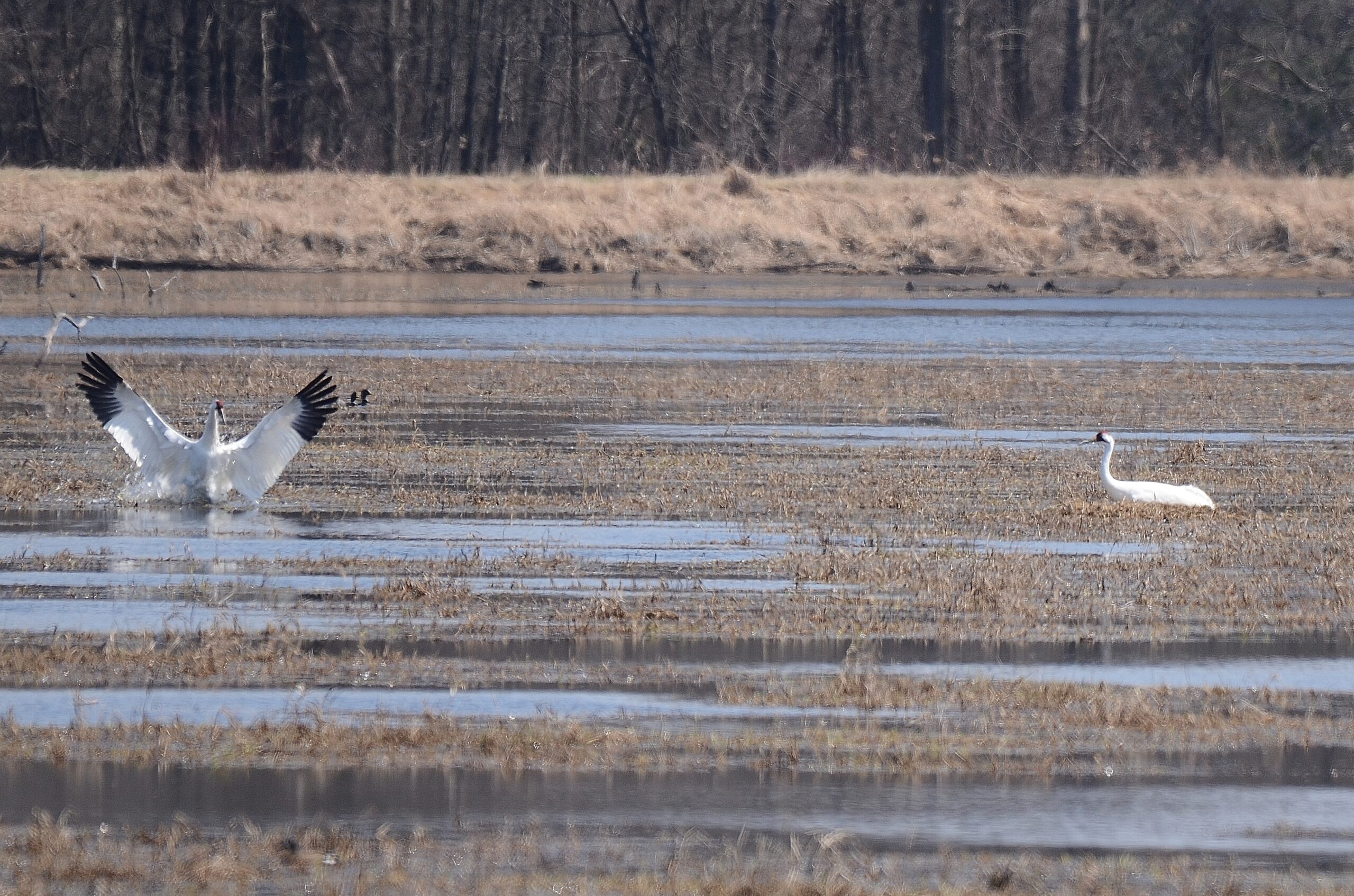
13-02 and 24-08 were first seen nesting on April 8. However, when the pair began nesting, researchers looking at the genetics of the new pair realized that they are actually full siblings! This is not the first time in the Eastern Migratory Population that a sibling pair has nested, but scientists will continue to watch the pair and see how it may impact their success.
The eggs from the first nest were removed as part of the forced renesting program, so the pair began renesting in early May. The pair hatched one chick, W18-19, who died shortly after hatching. In addition, the second egg was found broken near the nest with a developing chick inside. This indicates that despite being full siblings, the pair can still produce fertile eggs!
Fall 2019: 13-02 and 24-08 spent the summer together on their territory at Necedah National Wildlife Refuge. They left Wisconsin around the end of October, and showed up at Wheeler National Wildlife Refuge mid-November, where they spent the winter with other Whooping Cranes. In January they moved slightly north to Madison County, Alabama, where 24-08 had wintered with her previous mate in the past. The pair stayed in Alabama until the end of February.
Spring 2020: In early March, 13-02 and 24-08 started heading north, making a stop in Edwards County, Illinois. They arrived back on the breeding grounds by early April and began nesting shortly thereafter. They incubated their first nest for the full 30 days, but we did not document a hatch. The pair began re-nesting in early June and we hope they will hatch a chick!
Fall 2020: 13-02 and 24-08 hatched the last chick of the season at the beginning of July! Their chick W18-20 fledged and the family was one of the last ones to migrate at the end of November. We were able to monitor the family’s migration after replacing 13-02’s non-functioning transmitter in fall with a new satellite transmitter! They stopped in multiple states on their long journey down to northern Alabama at the end of December.
Spring 2021: 13-02 and 24-08 joined several other Whooping Cranes migrating north and stopped in Kentucky and Illinois for several days. In late March they made it to Necedah National Wildlife Refuge. At the end of April, they started incubating and hatched 1 chick which sadly did not survive. Since then, they’ve been foraging and flying around their Necedah territory.
Fall 2021: This fall 13-02 and his mate 24-08 left their breeding territory in Necedah NWR for their wintering grounds at Wheeler NWR in Alabama. They Left Wisconsin in mid-November and stopped for a rest in Edwards County, IL before continuing south.
Spring 2022: 13-02 and his mate 24-08 wintered in Morgan County, Alabama before migrating back up to Wisconsin in late March. The pair stopped in Columbia County, WI, then returned to their breeding grounds at Necedah NWR shortly after. 13-02 and 24-08 were seen in April with their first nest but ultimately abandoned. They had a second nest at Necedah NWR, and hatched a chick, known as W12-22! Fingers crossed for their little one!
Fall 2022: Unfortunately, W12-22 disappeared in late July. 13-02 and 24-08 spent the rest of the summer on their territory at Necedah NWR and migrated to their usual wintering grounds in Morgan County, Alabama.
Spring 2023: Pair 13-02 and 24-08 kept to themselves on their wintering grounds in Morgan County, Alabama, and began their migration back to Wisconsin in early March. After a stopover in Wabash County, Illinois, the pair was spotted back on their territory at Necedah NWR on March 30. By early May, the pair was sitting on a nest and in early June they welcomed W12-23, the 12th wild-hatched chick of the year. They have been seen with their chick throughout July, and we hope to continue seeing this family group as they prepare for migration!
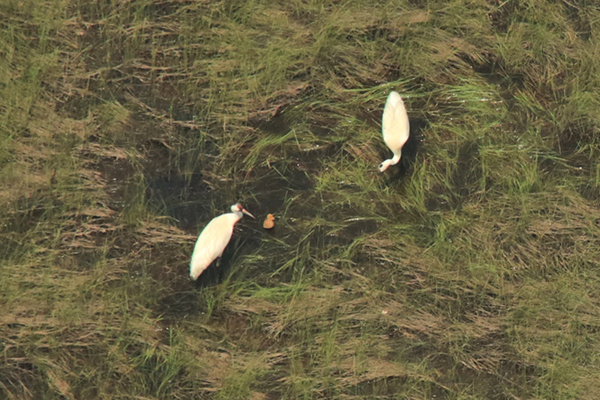
Fall 2023: 13-02, 24-08, and their chick W12-23 left Wisconsin in early November and headed to Kane County, Illinois on their way to their wintering grounds in Morgan County, Alabama. This journey only took five days to complete, and they were some of the first Whooping Cranes to arrive in Alabama this fall. Since their arrival, they have been exploring the area and all of the resources Wheeler NWR has to offer.
Click here to jump to the top of this page.
Crane #14-02
Sex: Female
Hatch Date: May 16, 2002
Personality Characteristics: She is a fairly quiet female. She is sometimes shy, but is eager to work with the trikes and costumes.
History
Fall 2002: On the migration, she dropped out during the first flight and returned to her pen at Necedah. Also dropped out on the 4th leg of the migration, but successfully migrated to Florida with the ultralight Class of 2002. First crane in her class to acquire her adult voice.
Spring 2003: Left Florida on first journey north April 1 with all the rest, but hesitated and turned back alone. Left again on April 2 and chose her own route north. Located by aerial search on May 13 on a remote pond in north central Illinois where she stayed all summer. She is the only crane from the Class of 2002 that did not return to Wisconsin in spring 2003.
Fall 2003: As of Nov. 21, when flock mates were in Florida, she was still in Illinois with sandhill cranes. The last to migrate south in 2003, she began her migration Nov. 28 and arrived at the FLorida pen site on December 2. This lone crane then moved to Madison County. During the winter (on February 7, 2004) she again showed up at the pen site, joining all the new 2003 chicks as well as 3 older “ultra-cranes:” #5-01 and #2-02 and #18-02 from her own class. The older birds tried to chase her away, but eventually stopped.
Spring 2004: #14-02 stayed back with the chicks when the older whoopers (#5-01, #4-02, #18-02) left on migration March 27. When the other young chicks left on April 7, she remained at the pen site — now by herself (and probably glad!). The first visual of the bird, flying alone, was obtained near Amboy, Illinois, at 1:14pm on April 17. Crane #14-02 landed at 4:45pm in Lafayette County, Wisconsin — her first time back on Wisconsin soil since the fall of 2002. (She chose northern Illinois as her summer home in 2003.) She was seen in summer 2004 in Monroe County, Wisconsin.
Fall 2004: #14-02 was spotted migrating with four sandhill cranes northwest in Indiana on November 7, 2004. She was the first ultra-crane to arrive in fall 2004 at Chassahowitzka, first seen there on Nov. 16. She joined wintering sandhill cranes on a cattle ranch in Sumter County, Florida. She returned to the Chassahowitzka pen site on January 29, 2005. Cranes #11-02, #12-02 and #17-02 were also there, and they were intolerant of #14-02. On Feb. 1, #12-02 was seen chasing #14-02 in an aerial dogfight.
The remains of #14-02 were discovered Feb. 6 about 1 mile southeast of the chick’s Florida pen. She likely died Feb. 1 or 2, 2005, the apparent victim of a bobcat.
Click here to jump to the top of this page.
Crane #15-02
Sex: Female
Hatch Date: May 17, 2002
Personality Characteristics: During the first winter in Florida, Sara said she was a rather submissive, low-ranking bird who rarely bothered anyone, yet she was bullied by Yearling Crane #5-01.
History
Fall 2002: Migrated successfully to Florida with the ultralights and Class of 2002.
Spring 2003: Left Florida in the group of 15 (included one 2001 bird) and arrived back in Wisconsin April 13. Wandered in her first summer. She and females #3-02 and #7-02 stayed in South Dakota. This worried experts because it was too close to the Aransas/Wood Buffalo Whooping crane path and outside the NEP area. The three females were captured and returned to Necedah August 17-18. Crane #15-02 stayed around the Refuge until she reunited with #3-02 on August 29, and both flew to northeastern Iowa.
Fall 2003: #15-02 and #3-02 began migration from Iowa on November 8 and completed their return to Citrus County, Florida 7 days later. They were the first to arrive. After staying at the pen site, they later moved and were seen Nov. 21 in a marsh in Hillsborough County, FL. Then the two moved to Sumter County, where they spent the winter.
Spring 2004: They left on spring migration after April 11, 2004. Finally, #3-02 and #15-02 were reported in Meeker Co., Minnesota, between April 17-18. These are two of the three females that wandered west into South Dakota in spring 2003, but they were reported back at Necedah April 19!
Fall 2004: Cranes #3-02, #15-02 and #16-02 began migration from Monroe County, Wisconsin, on November 21. They left Greene County, Indiana on December 14. They roosted that night along a river in Davidson County, Tennessee. On Dec. 15 the trio flew to Limestone County, Alabama, remaining there in harvested cornfields and floodings until Dec. 23rd. On that morning #15-02 separated from the other two birds. She couldn’t be located due to weak and infrequent radio signals. On January 3, 2005, her body was recovered in Limestone County, Alabama by WCEP trackers. Her death is under investigation, with no certain answers.
Click here to jump to the top of this page.
Crane #16-02
Sex: Male
Hatch Date: May 17, 2002
Personality Characteristics: Always the runt as a chick, but grew to become one of the largest males. Good flyer. Third most-dominant male. As a chick he wanted to fight anything that moved, but later was a good, normal bird. One of the pilots’ favorite flyers.
History
Fall 2002: Completed the journey south with ultralights and the Class of 2002. During the first winter in Florida, Sara said, “He’s a large male and is somewhere in the middle of the hierarchy, but is rather mellow and doesn’t seek out challenges or fights.”
Spring 2003: Left Florida on first journey north April 1, 2003 with 14 other whoopers and returned successfully to Wisconsin on April 13. Spent the summer about 15 miles from Necedah NWR with flock mates #17-02, #2-02, #11-02, #12-02 and #13-02.
Fall 2003: Began migration on Nov. 13 with six flock mates and #2-01. This group of eight arrived at the “Chass” pen site in FLorida on November 21, 2003. During their entire journey south, the group stayed together and was never seen migrating with sandhill cranes. This group moved to Pasco County shortly after arriving in FL. Five of them, including #16-02, split from the group and moved to the area of Pasco County that #1-01 and #2-01 occupied in winter 2002.
Spring 2004: Left on spring migration around March 13, 2004, together with #1-01, #2-01, #5-02, #8-02, and #17-02. PTT readings indicated the group roosted in SW Indiana on March 22, but moved to DeKalb County, IL March 23. The group arrived back at Necedah NWR on April 1, 2004.
Fall 2004: Cranes #16-02 (with #3-02 and #15-02) began migration from Monroe County, Wisconsin, on November 21. They left Greene County, Indiana on December 14. They roosted that night along a river in Davidson County, Tennessee. On Dec. 15 the trio flew to Limestone County, Alabama, remaining in harvested cornfields and floodings there until Dec. 23. Crane #15-02 then left them, but #16-02 and #3-02 arrived at the winter pen site on the afternoon of Dec. 28. Moved to a ranch in Lake County, FL for most of the winter.
Spring 2005: #16-02 Began migration with #3-02 during March 22-24. In summer and fall, he spent time with #303 on Necedah NWR.
Fall 2005: Began migration Nov. 17 with #3-03. They were tracked into northern IL, but their roost site was not determined. No further reports until they arrived at their old Florida pen site on December 14. They moved later to a ranch in nearby Pasco County, FL.
Spring 2006: #16-02 left Florida around March 6 with #3-03. They were reported March 19 in Tennessee. Male #16-02 and his mate, #3-03, were the only one of last year’s breeding pairs that had not arrived on their territory in Central Wisconsin by April 7. #16-02 was reported that day in central Minnesota. The location and fate of #3-03 was not known until, amazingly, she turned up at Necedah NWR on April 12. The pair’s separation may have been related to severe storms that occurred during migration. Crane #16-02 stayed in Minnesota for the rest of that week. On April 18 at 4:14 PM, he landed within his territory on Necedah NWR! His injury was apparent. Read what happened (video clip too). By April 20 he had moved to the Mill Bluff State Park area. On April 21 he returned to his territory at Necedah NWR and rejoined #3-03. The pair stayed together and returned to Mill Bluff on April 22. But he soon lost his territory at Necedah AND his his mate, #3-03, to young bachelor #8-04. Male #16-02 recovered during the summer and currently occupies the area adjacent to and east of his former territory.
Fall 2006: #16-02 left Wisconsin on Nov. 19 with #16-05 and 32-05 (DAR) and made it that night to SE Indiana. Both other birds made it to Florida, but #16-02 went off on his own path. He migrated successfully and was on his wintering area on a cattle ranch in Pasco County, FL in December.
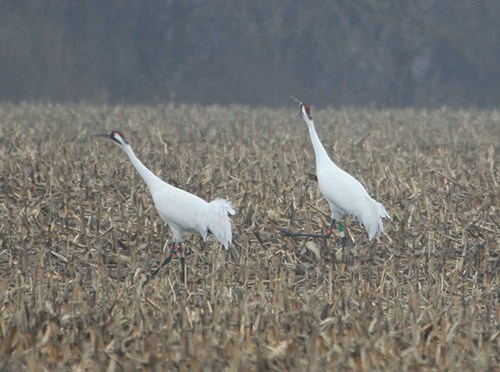
Spring 2007: He began migration March 5 (with #2-01). Crane #16-02 was found at Necedah NWR on March 26. He had separated from #2-01.
Fall 2007: Crane #16-02 joined with #3-03 and #17-03 around Necedah NWR on Nov. 20 and left with them on migration on November 22. He wintered in Pasco County, Florida.
Spring 2008: Began spring migration on February 29. He was first seen on the refuge back in Wisconsin on April 2. He has a nonfunctional transmitter, so it was a thrilling sight!
Fall 2008: Crane #16-02 got a new radio transmitter in October, before fall migration. Male #16-02 led the way on ’08 fall migration for four DAR chicks’ first migration, and returned with them in spring ’09.
Fall 2008: On November 17 crane #16-02 began migration along with 2008 DAR chicks #31-08, #32-08, #36-08, and #38-08 and roosted that night near Ogle County, Illinois! They were still in northern Illinois as of Dec. 1. On Dec. 5 they arrived in Lawrence County, Tennessee, where they remained. Will #16-02 lead these young chicks all the way to Florida and teach them the flock’s migration route? They were still there, in good crane habitat, in January. Good job, #16-02!
Spring 2009: Trackers think #16-02 left on migration with his wintering group of four DAR youngsters, since DAR #31-08 began migration north from Lawrence County, TN on March 17th or 18th. PTT data indicated that he (and probably the four DAR birds) stopped in Gallatin County, IL on March 18 and Rock Island County, IL on March 20. The group likely reached home on the night of March 22, as all were confirmed at Necedah on March 23. Biologists celebrate the fact that all four DAR birds continue to associate with Whooping cranes and not hang out solely with Sandhill cranes. Good job, #16-02! This male began closely associating with female #16-07 by March 27 and the two were observed unison calling on that day. But the match did not last and they had parted by mid June. But not for long…
Fall 2009: Crane #16-02 left Necedah NWR on migration November 26, migrating in a group with several other departing Whooping cranes before landing to roost at an undetermined location(s) in Illinois. Then male #16-02 and female #16-07 continued with #12-05/#22-07 and (DAR) 38-09. The group was located by aerial survey while in flight over Clark County, Illinois, on Nov. 27. They landed to roost in Lawrence County, Illinois, and on Nov. 28 continued ~20 miles SE to Knox County, Indiana. They were still there Feb. 6.
Spring 2010: Crane pair #16-02/#16-07, pair #12-05/#22-07, and 38-09 (DAR) remained along the Wabash River, in Knox County, Indiana until they began migration on March 17. A low precision PTT reading for #22-07 indicated a roost location in Dane County, Wisconsin, on the night of March 20. Were the others with her? Male #16-02 was reported back on Necedah NWR by March 24 but his mate #16-07 separated from him (again!) and apparently paired with #16-03 (for now).
Fall 2010: Male #16-02, back again with mate #16-07 were reported with cranes #4-08 and #10-09 in Knox County, Indiana, on November 28. They remained there at least through December 10. They were found at a previous wintering area of #16-02 in Lawrence Co, Tennessee on February 8. The area had not been checked earlier, and they may have been here since moving from Knox County, Indiana.
Spring 2011: Male #16-02 and mate 16-07 on March 1 were reported in Wayne County, Illinois, where they remained at least through March 4. The pair had completed migration to the Wisconsin core area by March 21. Soon this pair was nesting for the first time! But alas, they weren’t on their nest when it was checked on April 24. One egg was removed from the nest but unfortunately the egg was already cold and as a result unlikely to be viable.
Fall 2011: Migrated with #16-07 to Knox County, Indiana.
Spring 2012: Male #16-02 (assumed to be with his mate #16-07) was detected in flight March 15 with several other Whooping cranes as they headed north over ICF in Baraboo, Wisconsin—close to Necedah NWR. They were sitting on a nest on April 5. That nest failed but they had a second nest by May 7 and Chick W9-12 hatched on June 5! The chick did not survive the summer.
Fall 2012: On Nov. 21 he and his mate #16-07 were discovered in Gibson County, Indiana. Also present there were pair #12-05 /#22-07 and males #19-09 and #25-10 DAR.
Spring 2013: Male #16-02 and his mate #16-07 completed spring migration March 30. They soon had a nest together, but it failed and they re-nested. This nest, too, was abandoned but both eggs were rescued and taken to ICF for incubation. The eggs successfully hatched May 17 and May 18 to become chicks #7-13 and #8-13 for the Class of 2013 ultralight-led fall migration.
Fall 2013: Male #16-02 and his mate #16-07 migrated to Gibson County, Indiana, where they were last reported through Feb. 2014, with #19-09. ICF tracker Eva took this photo on Feb. 12, 2014 with support from Windway Aircraft:
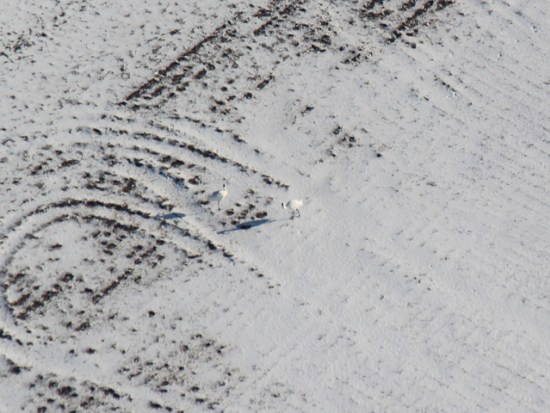
Spring 2014: Male #16-02 and his mate #16-07 completed spring migration to Necedah NWR March 28. The pair nested in Juneau County, and the nest was still active as of April 30 but failed in May when parents abandoned it.
Fall 2014: Male #16-02 was captured for transmitter replacement on September 16. A health check was also performed. They looked at the condition of his wing feathers and also his leg, which was broken several years ago. His leg shows thickening from the healing process.
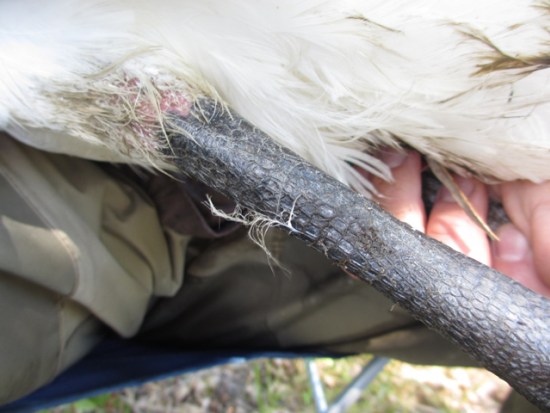
Crane #16-02 and mate #16-07 began fall migration from Necedah on November 8th, 2014. They wintered in Gibson County, Indiana.
Spring 2015: Pair #16-02 and #16-07 returned to Necedah NWR and nested. Those first eggs were removed Aprl 16 by experts in the forced renesting program, but their second nest produced chick W21-15 on June 1 and W22 on June 2. One chick (W22) survived and was seen alive on June 23. Here’s a parent and chick on June 8. One chick survived and was seen alive on June 23, but did not survive to fledge.
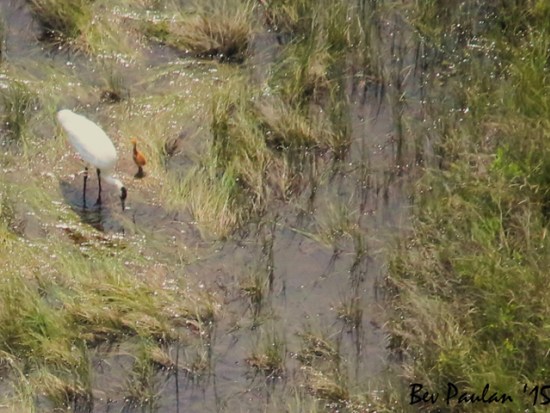
Fall 2015: Male #16-02 and his mate #16-07 migrated to Gibson County, Indiana.
Spring 2016: Pair #16-02 and #16-07 were observed back on territory at Necedah NWR by the March 30 aerial survey flight. The pair were observed on a nest on a May 19 survey flight. Their new chick, W18-16, hatched on June 5 but did not survive into the summer.
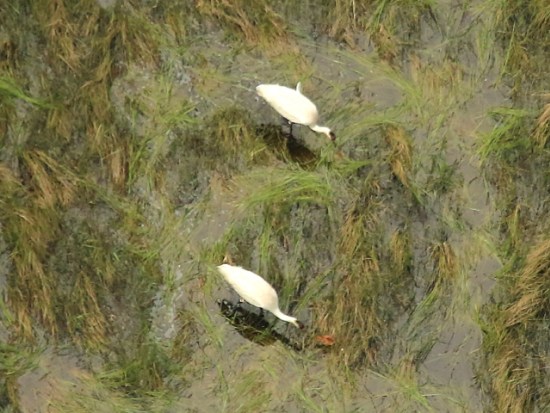
Fall 2016: Pair #16-02 and #16-07 were still in Wisconsin as of Nov. 25 but male #16-02 was reported on wintering grounds in Gibson County, Indiana in late December. It seems male #1-04 wooed away female 16-07, leaving male 16-02 alone.
Spring 2017: Back in Wisconsin, male #16-02 is currently a “lonely old bachelor,” noted Operation Migration’s Heather Ray. Sadly, Bev Paulan reports the remains of number 16-02 were collected by Necedah Refuge field staff in late July.
Click here to jump to the top of this page.
Crane #17-02
Sex: Female
Hatch Date: May 18, 2002
Personality Characteristics: Usually quiet little chick. According to Dan, she doesn’t like smelt for a treat — a very unusual trait! But just see what this chick did later in her history-making life:
History
Fall 2002: Successfully finished her first journey south behind ultralight plane.
Spring 2003: Left Florida on first journey north April 1, 2003 with 14 other whoopers. Returned successfully to Wisconsin April 13. Spent the summer about 15 miles from Necedah NWR with five flock mates.
Fall 2003: Began migration on Nov. 13 with six flock mates and #2-01. This group of eight arrived at their old pen site in Florida on November 21, 2003. During their entire journey south, the group stayed together and didn’t even mix with sandhill cranes. This group left the old pen and moved to Pasco County shortly after arriving in Florida. Five of them, including #17-02, split from the group and moved to the same area of Pasco County that #1-01 and #2-01 occupied in winter 2002.
Spring 2004: Left Florida on spring migration around March 13, together with #1-01, #2-01, #5-02, #8-02, and #16-02. PTT readings indicated the group roosted in Indiana on March 22, and moved to DeKalb County, IL March 23. They arrived home at Necedah NWR on April 1, 2004.
Fall 2004: Remained at or near Necedah NWR (along with #11-02 and #12-02) until Dec. 11. Arrived at the Florida pen site December 15—flying the whole route in just 4-1/2 days! They roosted that night in the pool within the pen, near the top-netted enclosure containing the 13 newly-arrived 2004 chicks. On December 16th they stayed at the pen all day and night. On December 17 these 3 moved to the marsh 1 mile west of the enclosure but visited the pen often. The trio of #17-02, #11-02 and #12-02 moved on Dec. 26th to the Pasco County site, which was used by #11-02 and #12-02 during winter 2003-04. Cranes #17-02, #11-02 and #12-02 sometimes returned to the pen site. They were hostile to #14-02 when she also returned in February, and they drove her away.
Spring 2005: Crane #17-02 (with #5-02, #11-02, and #12-02) departed Pasco County, FL between March 10 – 12. Confirmed back at Necedah NWR in Wisconsin by March 29. On the evening of 17 April, #17-02 (female) stayed on the nest the pair built in the pond on the east side of the dike, while #11-02 (male) roosted alone on the west side of the dike on their pond. This behavior could indicate that laying of an egg is imminent. Sure enough! They laid an egg in their nest, probably April 19. Unfortunately, the pair left the nest site and moved off the refuge by late afternoon, leaving the nest unattended during the night. The next morning the egg was gone, apparently taken by a raccoon or other predator. The pair remained together on or near their territory at Necedah NWR all summer. In the fall they foraged in a field along with the direct autumn release (DAR) chicks with only minor aggression. If other adults appeared around the DAR chicks’ home, pair #17-02 and #11-02 usually drove them away.
Fall 2005: Began migration from Wisconsin shortly after sunrise on Nov. 24 with #11-02. They were not tracked. The pair reached their former pen site in Florida on December 1. They moved to a ranch in nearby Pasco County and sometimes associated with #5-02 and #13-03, as well as with small groups of sandhill cranes.
Spring 2006: Crane #17-02 (together with #11-02) began migration from a cattle ranch in Pasco County, Florida on February 28. They apparently arrived on their territory at Necedah NWR in Wisconsin on March 28. They built a nest and were confirmed incubating on April 11! But on April 20 both these adults were seen foraging together, an indication that their nest had failed. Biologists examined the nest site on the morning of April 21. No egg remains were found in or near the nest. A crane egg shell, believed to be from this Whooping Crane nest, was found on the dike about 300 meters from the nest, probably carried there by an avian predator. See photos. Then—surprise! This pair nested again and began incubating on May 23 at the original nest site they used last year. This time they stayed with their eggs. On June 22, 2006, experts watching through binoculars saw that the adult cranes’ behavior had changed. The eggs had hatched! Twin chicks were confirmed on June 23. What a celebration! The new Eastern flock has its first family!
Fall 2006: The First Family left on their first migration south on Nov. 19, the day that a record total of 28 whooping cranes began migration. The parents and their surviving female chick (called W1-06) made it that day to Indiana! On December 9, 2006 at 4:08 pm parents #11-02 and #17-02 and their surviving chick arrived at the Florida pen site. The new parents brought their chick to the same place THEIR parent, the ultralight plane, brought them in 2002. WELL DONE! The family later moved to a lake in a large housing development in Hernando County, FL (not a good idea). They left that location in after February 22.
Spring 2007: The First Family (Mom #17-02, Dad #11-02, and chick #W1-06) began migration from Florida on Feb. 23. No further confirmed reports were received until March 20 when the radio signals of #11-02 and #17-02 and their chick #W1-06 were confirmed back on Necedah National Wildlife Refuge in Wisconsin! Their chick is the first wild-hatched chick in the eastern migratory population, and the first to complete a round trip migration by following her parents — a milestone for the reintroduction of this new flock! By March 26, the chick had separated from the parents (normal behavior). The adults built a new nest and began incubating eggs on April 3. The nest was later abandoned; they began building another nest around May 17, but they did not hatch eggs this year.
Fall 2007: Pair #17-02 and #11-02 left on migration November 22, 2007. Found in Vermillion County, Indiana, on November 24 and still there when trackers checked on December 13. They were gone when the area was checked on December 23. On January 3, 2008, ICF tracker Eva detected signals for #11-02 and #17-02, the First Family parents. Eva confirmed the birds had landed at the Chassahowitzka pen site by making a trip to the boat ramp where she could once again hear their signals coming from the direction of the pen site. They stayed the night at the pen site. Eva wondered where they’d go next. She monitored them. The next morning they took off at 11:30. At noon they landed on their former territory and found W1-06, their female offspring from 2006!
Juvenile W1-06 was on her parents’ territory when they arrived on January 4, 2008. Eva watched the family reunion. All three whooping cranes were less than a meter apart then W1-06 started walking away. The parents caught up with her and all three walking, then stopped and foraged together. It will be interesting to see what happens next. Will they chase the youngster away, which would be expected behavior? Trackers will continue to monitor these three birds closely to see how they interact.
On Feb. 15, 2008, the two adults left their territory and flew to visit their old “Chass” pen where the Class of 2007 now lives. The adults landed in the pen and the chicks immediately ran and flapped to them, attacking intruders who dared enter their territory. The adults took the hint and flew a short distance away, with chicks on their tails. They were chased from the pen in a matter of minutes, flying to the west to land in a nearby creek. They got the message and didn’t come back!
Spring 2008: On February 16 or 17, the pair left their winter territory. They were not tracked, but First Parents #11-02 and #17-02 (parents of W601) were confirmed at Necedah NWR on March 25. The pair began incubating on April 7. Hopes for chicks were dashed when they deserted their nest on May 6, with 2 fertile eggs, after a surge of warm weather. This is the second time the pair has abandoned a nest.
Fall 2008: Began migration from Necedah NWR on November 15 with mate #11-02. They were found in Cherokee County, Alabama, at the end of December and beginning of January.
Spring 2009: Began migration from Cherokee County, Alabama, before March 8 with mate #11-02. Reported in Vermilion County, Indiana during March 9-14. (The refuge data-logger detected the presence of one bird at Necedah NWR on March 16.)
Both birds were confirmed there on March 19 and incubating on a nest April 7. Black flies that hatched in a heat wave tormented the nesting adults and he nest failed before the eggs could hatch. The pair built a second nest — and became the new flock’s first second-time parents when their chick hatched in June! The behavior of the pair indicated that the chick hatched on June 14 or 15, but visual confirmation was difficult to obtain until June 18 due to dense vegetation. This chick is W2-09 (W for wild, 2 for second hatched in the year 09). HOORAY! This is the second time in over a century that a naturally produced Whooping crane has hatched in the wild in the Midwest, and both came from pair 11-02 & 17-02!
Sadly, W2-09 disappeared at just two weeks of age. The chick was last visually confirmed at 1:00 p.m. on June 28. The parents seemed to be tending the chick the early evening of June 29, but the chick could not be seen due to marsh vegetation. The parents were first observed behaving as if no chick was present around noon on June 30, and the movements of the parents have confirmed the loss of the chick.
Pair #11-02 & 17-02 did a lot of flying between the pen site of the DAR chicks and the pen site of the ultralight chicks over the last weeks of summer and early fall.
Fall 2009: Female #17-02 was captured for transmitter replacement on October 19. She and mate #17-02 began migration from Necedah NWR with several other Whooping cranes on Nov. 26, migrating as a group before landing to roost at an undetermined location(s) in Illinois. On Nov. 28 the pair was at one of their previously used stopovers in Vermillion County, Indiana.
Female #17-02 was killed by a gunshot shortly after this sighting. She was 7 years old. Indiana Department of Natural Resources conservation officers and U.S. Fish and Wildlife Service special agents are conducting a joint investigation into the incident. The crane was shot sometime between Saturday, Nov. 28, when it was observed by Eva Szyszkoski, ICF Tracking Field Manager, and Tuesday, Dec. 1, when ICF tracking intern Jess Thompson found the carcass. The U.S. Fish and Wildlife Service is offering a minimum reward of $2,500 to the person or people who provide information leading to a conviction. Anyone with information should call the Indiana Department of Natural Resources 24-hour hotline at: 1-800 TIP IDNR (800-847-4367), or the U.S. Fish & Wildlife Service at 317-346-7016. Callers can remain anonymous.
Female #17-02 and her mate (#11-02) nested during each of the past 5 springs on their territory at Necedah NWR. They hatched two chicks and fledged one #W1-06 in 2006, becoming the first pair in the EMP to successfully raise a crane chick to fledge. Crane #11-02 and #17-02 were known as the “first family” in the new Eastern flock. The death of this breeding female is a huge loss and very sad news indeed.
KILLER CAUGHT AND SENTENCED: April 2011 News Release
Click here to jump to the top of this page.
Crane #18-02
Sex: Female
Hatch Date: May 21, 2002
Personality Characteristics: One of the two youngest in the flock. She is small and very bonded to the ultralight. Can be quite fiery at times towards handlers and flock mates, but not often. Dan says she’s cute and cries a lot and is another favorite because of her small size.
History
Fall 2002: Successfully finished her first journey south behind ultralight plane.
Spring 2003: Successfully completed first migration north in spring 2003, leaving Florida in a group of fifteen (included one 2001 bird) and arriving Wisconsin April 13. Spent the summer about 10-12 miles from the Necedah Refuge with #4-02 and #9-02 and returned to the Refuge the last week of October, 2003.
Fall 2003: Migrating together, 18-02, 5-01, and 4-02 were found by trackers while in flight Nov. 20 over Georgia. They flew after dark, roosting in SW Georgia. On November 21 the group of three landed at the pen site at Chassahowitzka, migration complete! They later flew to Hernando County, but returned on Jan. 8, 2004 to the pen site to create trouble. They harassed the new arrivals (young 2003 chicks) in the pen and defended and took over a feeding station.
Spring 2004: Left on spring migration March 27, together with #5-01 and #4-02. They landed to roost in Crisp County, GA at 6:15 that evening. Stopped overnight in Indiana April 1. Confirmed back at Necedah on April 7, 2004 with #5-01 and #4-02.
Fall 2004: Began migration Nov 21. The trio of #9-02, 13-02 & 18-02 remained in a flooded area in Franklin County, TN as their wintering grounds.
Spring 2005: Began migration with #9-02 and 13-02 from Franklin County, TN on March 21. Confirmed back at Necedah NWR in WI by March 29. The pair #18-02 and #13-02 began building a nest near the site two training area! However, the nest was never completed and no eggs appeared. This pair moved between the refuge and the Mill Bluff area but stayed on their territory at Necedah NWR most of the time.
Fall 2005: Began migration Nov. 17 with mate #13-02. On Nov. 23 they were back in Franklin County, TN, where they spent the winter of 2004.
Spring 2006: Observed with #13-02 on March 14, and they probably began migration soon after. They were observed March 19 on their territory at Necedah NWR in Wisconsin and building a nest by the end of March. They began incubating by April 6! Like good parents, they diligently tended the nest—but that changed on April 24. They left the nest for several hours. Experts rescued the eggs and replaced them with a dummy egg. The eggs became the Eastern flocks FIRST CHICKS!
Fall 2006: Despite a mass migration of a total of twenty-eight Whooping Cranes from Wisconsin on Nov. 19,#18-02 and mate 13-02 remained behind. But they successfully migrated south and were seen on their usual winter territory in Franklin County, Tennessee in December. They later moved to Wheeler NWR in Alabama.
Spring 2007: Completed migration with #13-02 to Necedah NWR on March 23. They built at least three nests at different locations in their territory during but none were successful. This egg was incubated in captivity and hatched into chick #17-07 for the Classs of 2007 ultralight-led chicks!
Fall 2007: Pair #13-02 and #18-02 left Wisconsin on November 22. Reported in Gibson County, Indiana, on November 24. Found on a wildlife refuge in Morgan County, Alabama, on November 28 and were still there at the end of December.
Spring 2008: This pair was visually confirmed back at Necedah NWR by March 30, when they were seen challenging mates #309 and #403 for that pair’s territory. On April 8 or 9, pair #218 and #213 began incubating on their new nest. On May 6 they abandoned their nest after a surge of warm weather. Their one good egg was saved and brought to ICF and then to Patuxent, where it hatched and became #5-08 for the Class of 2008 ultralight-led chicks. (The pair has not yet successfully nested and hatched an egg in the wild by themselves.)
Fall 2008: Began migration from Wisconsin on November 17, along with mate 13-02 and twelve other Whooping cranes. A week later pair #18-02 and #13-02 (along with a third crane) were on their wintering territory in Alabama!
Spring 2009: Pair #18-02 and #13-02 (and #24-05) likely began migration between March 9 and 13. Pair #18-02 and #13-02 were reported in Warrick County, Indiana on the morning of March 15. Confirmed at Necedah NWR in Wisconsin on March 19! They were observed nest building N on the evening of April 5. Began incubation April 16. Nest failed April 24.
When the Class of 2009 ultralight chicks had arrived and were training with the ultralight plane, #13-02 and #18-02 often came to watch and call and try to get close to the chicks. They seemed captivated by the chicks. The adult pair was NOT afraid of the “costume” that tried to scare them off just in case they might get aggressive with the chicks, or tempt the chicks to pay more attention to them than to the plane or costume.
Fall 2009: Crane #18-02 and mate #13-02 wintered at a national wildlife refuge in Morgan County, Alabama.
Spring 2010: Pair 13-02 & 18-02 began migration from Alabama some time after March 6. Two birds believed to be this pair were seen on/near their Wisconsin territory on March 15, and two days later the signal of #13-02 was detected. They are among the first arrivals back for the spring nesting season. All fingers are crossed for this pair to nest successfully. They were observed on a nest during an aerial survey on April 5! They later abandoned the nest and it failed, but tracker Eva discovered the pair on a new nest on May 8. The pair was still incubating those eggs on May 28 and everyone is hoping there will be chicks! As of June 13 the pair was still taking turns sitting on their one egg. The nest was expected to hatch five days ago. The egg is suspected to be infertile or non-viable.
Fall 2010: Crane names hereafter follow the naming conventions of WCEP: Migrating pair #18-02 and #13-02 were found in Will County, Illinois, on the afternoon of November 26, where they stayed at least through Dec. 2.
Spring 2011: Left Morgan County, Alabama wintering area after March 7 with mate 13-02. They completed migration to Necedah NWR area by March 21. The pair was incubating on their nest by April 12 but the nest failed about Apr. 30 and the pair was observed feeding in an area off the refuge on May 2.
Fall 2011: Crane #18-02 and mate #13-02 migrated to Alabama’s Wheeler National Wildlife Refuge and spent winter there.
Spring 2012: Crane #18-02 and mate #13-02 were detected arriving back at Wisconsin’s Necedah NWR on March 11, a perfect migration day. They were found with a nest on April 11! The chick was due to hatch on May 10. The pair were seen May 16 with a chick #W5-12. Chick W5-12 survived until July 24, 2012.
Fall 2012: Crane #18-02 and mate #13-02 began migration Oct. 31 and winterred at their usual location on Wheeler NWR in Alabama.
Spring 2013: Crane #18-02 and mate #13-02 were detected arriving back at Wisconsin’s Necedah NWR on March 30. They soon had a nest together, but the nest failed and the pair did not re-nest this summer.
Fall 2013: Crane #18-02 and mate #13-02 began migration Oct. 23 and winterred at their usual location on Wheeler NWR in Alabama.
Spring 2014: The first whoopers to be spotted in Wisconsin this spring were Crane #13-02 and mate #18-02! They were observed March 17 in Rock County, Wisconsin, foraging with a group of sandhills in a muddy field, and confirmed back at Necedah NWR on March 28, although they had likely arrived by the 24th.
Fall 2014: Crane #18-02 and mate #13-02 began migration from Necedah on November 8th and spent winter at Wheeler NWR, Alabama.
Spring 2015: Female #18-02, who has a nonfunctional transmitter, had likely returned with her mate #13-02 by mid March; her mate was seen during a March 25 aerial survey flight by Wisconsin DNR pilot Bev Paulan. The pair was later observed on an active nest, but the nest failed.
Fall 2016: Crane #18-02 and mate #13-02 migrated in November to their usual wintering range at Wheeler National Wildlife Refuge in Morgan County, Alabama.
Spring 2017: Female #18-02 and mate #13-02 returned to their Wisconsin territory and were nesting by April 5.
18-02 was last observed in early May.
Click here to jump to the top of this page.

